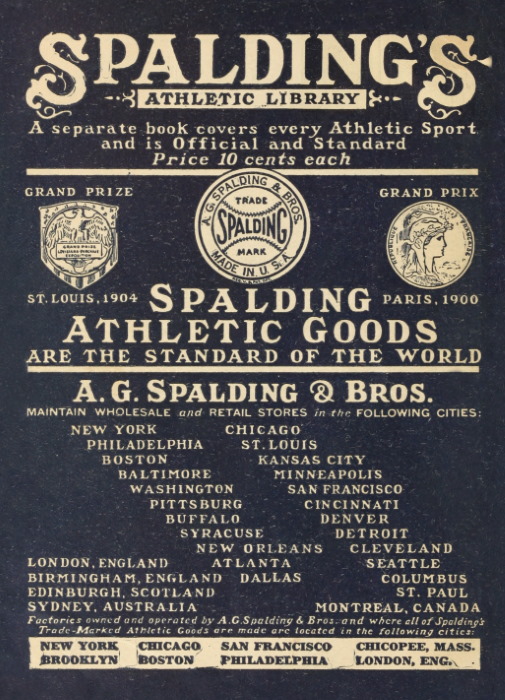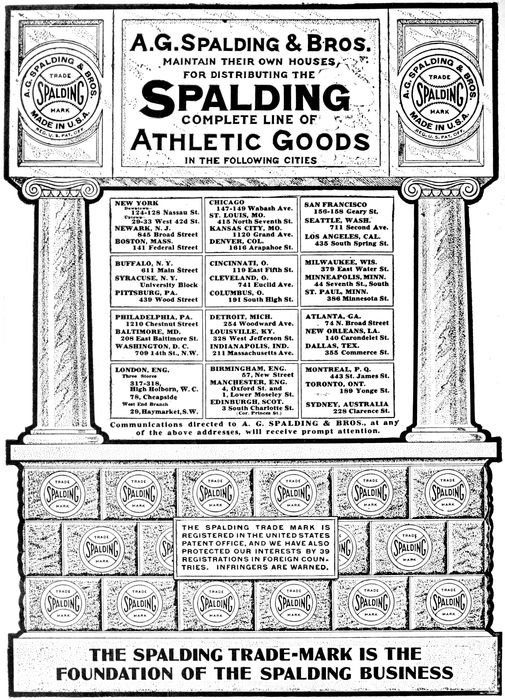
Transcriber’s Note:
The cover image was created by the transcriber and is placed in the public domain.

THE SPALDING TRADE MARK IS REGISTERED IN THE UNITED STATES PATENT OFFICE, AND WE HAVE ALSO PROTECTED OUR INTERESTS BY 39 REGISTRATIONS IN FOREIGN COUNTRIES. INFRINGERS ARE WARNED.
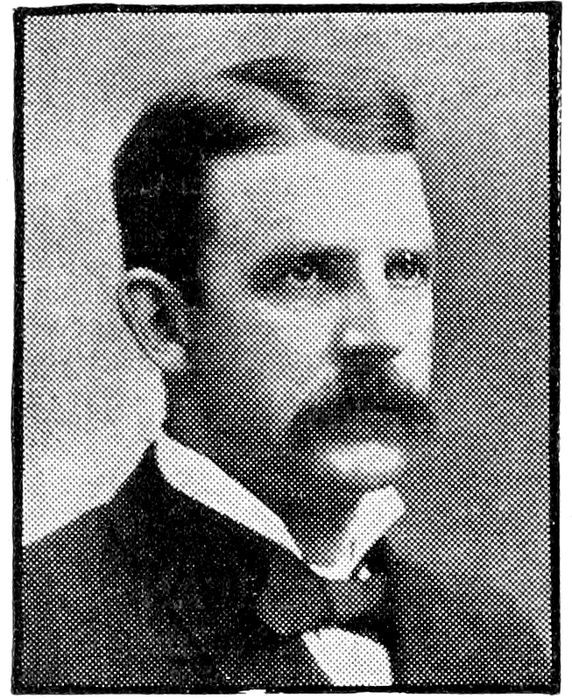
A. G. Spalding
Anticipating the present tendency of the American people toward a healthful method of living and enjoyment, Spalding’s Athletic Library was established in 1892 for the purpose of encouraging athletics in every form, not only by publishing the official rules and records pertaining to the various pastimes, but also by instructing, until to-day Spalding’s Athletic Library is unique in its own particular field and has been conceded the greatest educational series on athletic and physical training subjects that has ever been compiled.
The publication of a distinct series of books devoted to athletic sports and pastimes and designed to occupy the premier place in America in its class was an early idea of Mr. A. G. Spalding, who was one of the first in America to publish a handbook devoted to athletic sports, Spalding’s Official Base Ball Guide being the initial number, which was followed at intervals with other handbooks on the sports prominent in the ’70s.
Spalding’s Athletic Library has had the advice and counsel of Mr. A. G. Spalding in all of its undertakings, and particularly in all books devoted to the national game. This applies especially to Spalding’s Official Base Ball Guide and Spalding’s Official Base Ball Record, both of which receive the personal attention of Mr. A. G. Spalding, owing to his early connection with the game as the leading pitcher of the champion Boston and Chicago teams of 1872–76. His interest does not stop, however, with matters pertaining to base ball; there is not a sport that Mr. Spalding does not make it his business to become familiar with, and that the Library will always maintain its premier place, with Mr. Spalding’s able counsel at hand, goes without saying.
The entire series since the issue of the first number has been under the direct personal supervision of Mr. James E. Sullivan, President of the American Sports Publishing Company, and the total series of consecutive numbers reach an aggregate of considerably over three hundred, included in which are many “annuals,” that really constitute the history of their particular sport in America year by year, back copies of which are even now eagerly sought for, constituting as they do the really first authentic records of events and official rules that have ever been consecutively compiled.
When Spalding’s Athletic Library was founded, seventeen years ago, track and field athletics were practically unknown outside the larger colleges and a few athletic clubs in the leading cities, which gave occasional meets, when an entry list of 250 competitors was a subject of comment; golf was known only by a comparatively few persons; lawn tennis had some vogue and base ball was practically the only established field sport, and that in a professional way; basket ball had just been invented; athletics for the schoolboy—and schoolgirl—were almost unknown, and an advocate of class contests in athletics in the schools could not get a hearing. To-day we find the greatest body of athletes in the world is the Public Schools Athletic League of Greater New York, which has had an entry list at its annual games of over two thousand, and in whose “elementary series” in base ball last year 106 schools competed for the trophy emblematic of the championship.
While Spalding’s Athletic Library cannot claim that the rapid growth of athletics in this country is due to it solely, the fact cannot be denied that the books have had a great deal to do with its encouragement, by printing the official rules and instructions for playing the various games at a nominal price, within the reach of everyone, with the sole object that its series might be complete and the one place where a person could look with absolute certainty for the particular book in which he might be interested.
In selecting the editors and writers for the various books, the leading authority in his particular line has been obtained, with the result that no collection of books on athletic subjects can compare with Spalding’s Athletic Library for the prominence of the various authors and their ability to present their subjects in a thorough and practical manner.
A short sketch of a few of those who have edited some of the leading numbers of Spalding’s Athletic Library is given herewith:
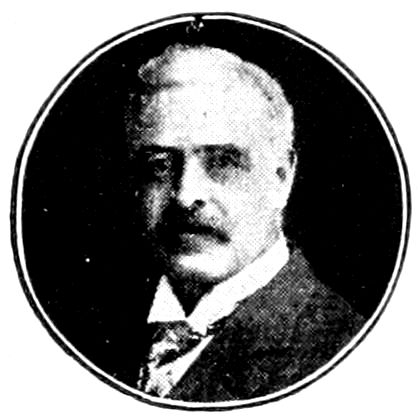
President American Sports Publishing Company; entered the publishing house of Frank Leslie in 1878, and has been connected continuously with the publishing business since then and also as athletic editor of various New York papers; was a competing athlete; one of the organizers of the Amateur Athletic Union of the United States; has been actively on its board of governors since its organization until the present time, and President for two successive terms; has attended every championship meeting in America since 1879 and has officiated in some capacity in connection with American amateur championships track and field games for nearly twenty-five years; assistant American director Olympic Games, Paris, 1900; director Pan-American Exposition athletic department, 1901; chief department physical culture Louisiana Purchase Exposition, St. Louis, 1904; secretary American Committee Olympic Games, at Athens, 1906; honorary director of Athletics at Jamestown Exposition, 1907; secretary American Committee Olympic Games, at London, 1908; member of the Pastime A. C., New York: honorary member Missouri A. C., St. Louis; honorary member Olympic A. C., San Francisco; ex-president Pastime A. C., New Jersey A. C., Knickerbocker A. C.; president Metropolitan Association of the A. A. U. for fifteen years; president Outdoor Recreation League; with Dr. Luther H. Gulick organized the Public Schools Athletic League of New York, and is now chairman of its games committee and member executive committee; was a pioneer in playground work and one of the organizers of the Outdoor Recreation League of New York; appointed by President Roosevelt as special commissioner to the Olympic Games at Athens, 1906, and decorated by King George I. of the Hellenes (Greece) for his services in connection with the Olympic Games; appointed special commissioner by President Roosevelt to the Olympic Games at London, 1908; appointed by Mayor McClellan, 1908, as member of the Board of Education of Greater New York.
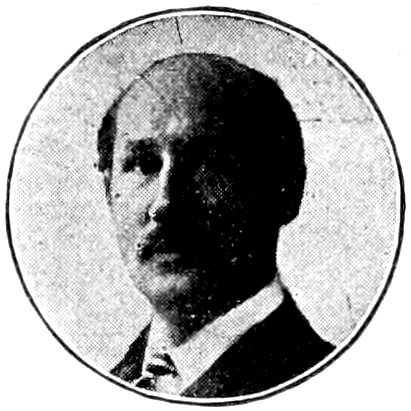
For quarter of a century Mr. Walter Camp of Yale has occupied a leading position in college athletics. It is immaterial what organization is suggested for college athletics, or for the betterment of conditions, insofar as college athletics is concerned, Mr. Camp has always played an important part in its conferences, and the great interest in and high plane of college sport to-day, are undoubtedly due more to Mr. Camp than to any other individual. Mr. Camp has probably written more on college athletics than any other writer and the leading papers and magazines of America are always anxious to secure his expert opinion on foot ball, track and field athletics, base ball and rowing. Mr. Camp has grown up with Yale athletics and is a part of Yale’s remarkable athletic system. While he has been designated as the “Father of Foot Ball,” it is a well known fact that during his college career Mr. Camp was regarded as one of the best players that ever represented Yale on the base ball field, so when we hear of Walter Camp as a foot ball expert we must also remember his remarkable knowledge of the game of base ball, of which he is a great admirer. Mr. Camp has edited Spalding’s Official Foot Ball Guide since it was first published, and also the Spalding Athletic Library book on How to Play Foot Ball. There is certainly no man in American college life better qualified to write for Spalding’s Athletic Library than Mr. Camp.
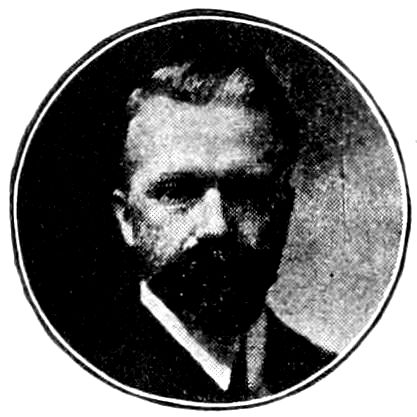
The leading exponent of physical training in America; one who has worked hard to impress the value of physical training in the schools; when physical training was combined with education at the St. Louis Exposition in 1904 Dr. Gulick played an important part in that congress; he received several awards for his good work and had many honors conferred upon him; he is the author of a great many books on the subject; it was Dr. Gulick, who, acting on the suggestion of James E. Sullivan, organized the Public Schools Athletic League of Greater New York, and was its first Secretary; Dr. Gulick was also for several years Director of Physical Training in the public schools of Greater New York, resigning the position to assume the Presidency of the Playground Association of America. Dr. Gulick is an authority on all subjects pertaining to physical training and the study of the child.
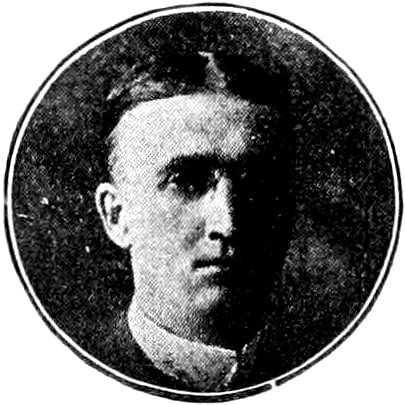
Successor to the late Henry Chadwick (“Father of Base Ball”) as editor of Spalding’s Official Base Ball Guide; sporting editor of the New York Evening Telegram; has been in the newspaper business for many years and is recognized throughout America as a leading writer on the national game; a staunch supporter of organized base ball, his pen has always been used for the betterment of the game.
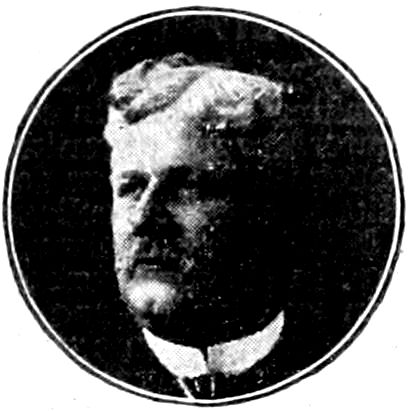
Base Ball editor of the Boston Globe and President of the New England League of Base Ball Clubs; one of the best known base ball men of the country; known from coast to coast; is a keen follower of the game and prominent in all its councils; nearly half a century ago was one of America’s foremost players: knows the game thoroughly and writes from the point of view both of player and an official.
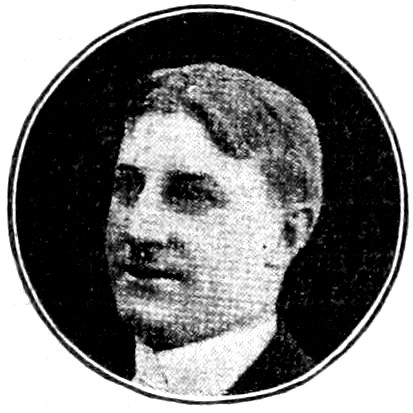
Sporting editor of the New York Times; graduate of the University of Pennsylvania; editor of Spalding’s Official Lawn Tennis Annual; is an authority on the game; follows the movements of the players minutely and understands not only tennis but all other subjects that can be classed as athletics; no one is better qualified to edit this book than Mr. Burchell.
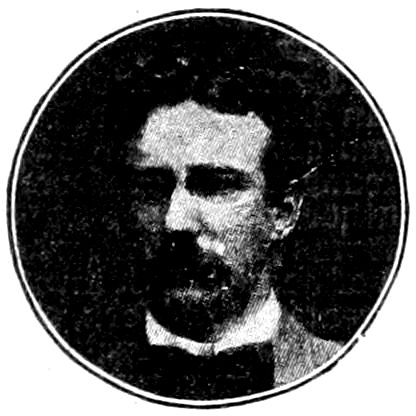
Former Young Men’s Christian Association director; for many years an official of the Athletic League of Young Men’s Christian Associations of North America; was connected with Dr. Luther H. Gulick in Young Men’s Christian Association work for over twelve years; became identified with basket ball when it was in its infancy and has followed it since, being recognized as the leading exponent of the official rules; succeeded Dr. Gulick as editor of the Official Basket Ball Guide and also editor of the Spalding Athletic Library book on How to Play Basket Ball.
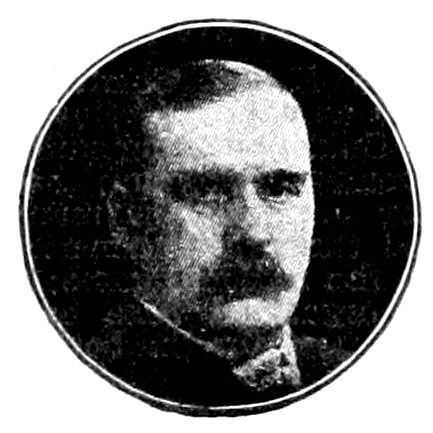
Former champion weight thrower; holder of numerous records, and is the winner of more championships than any other individual in the history of sport; Mr. Mitchel is a close student of athletics and well qualified to write upon any topic connected with athletic sport; has been for years on the staff of the New York Sun.
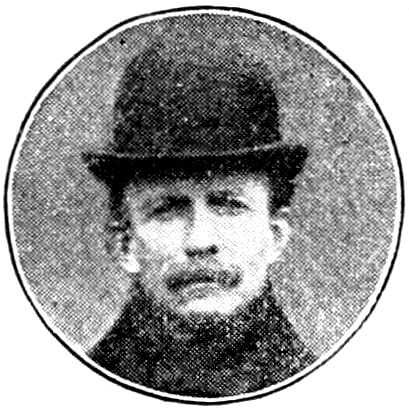
The world’s most famous athletic trainer; the champion athletes that he has developed for track and field sports, foot ball and base ball fields, would run into thousands; he became famous when at Yale University and has been particularly successful in developing what might be termed championship teams; his rare good judgment has placed him in an enviable position in the athletic world now with the University of Pennsylvania: during his career has trained only at two colleges and one athletic club, Yale and the University of Pennsylvania and Detroit Athletic Club: his most recent triumph was that of training the famous American team of athletes that swept the field at the Olympic Games of 1908 at London.
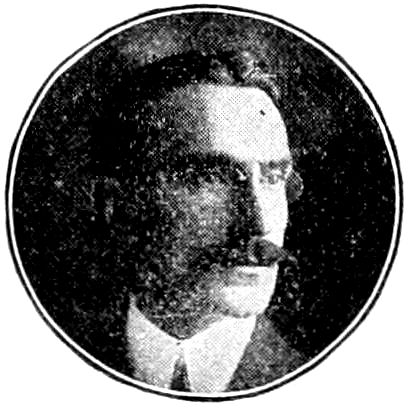
Succeeded Dr. Gulick as director of physical training in the schools of Greater New York: as secretary of the Public Schools Athletic League is at the head of the most remarkable organization of its kind in the world; is a practical athlete and gymnast himself, and has been for years connected with the physical training system in the schools of Greater New York, having had charge of the High School of Commerce.
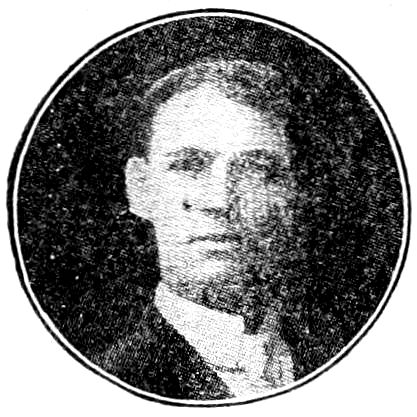
Has been connected with Y. M. C. A. work for many years as physical director at Cincinnati and Brooklyn, where he made such a high reputation as organizer that he was chosen to succeed Dr. Luther H. Gulick as Secretary of the Athletic League of Y. M. C. A.’s of North America, when the latter resigned to take charge of the physical training in the Public Schools of Greater New York.
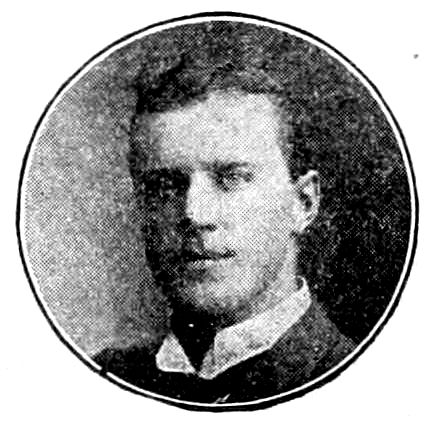
On athletics, college athletics, particularly track and field, foot ball, soccer foot ball, and training of the youth, it would be hard to find one better qualified than Dr. Orton; has had the necessary athletic experience and the ability to impart that experience intelligently to the youth of the land; for years was the American, British and Canadian champion runner.
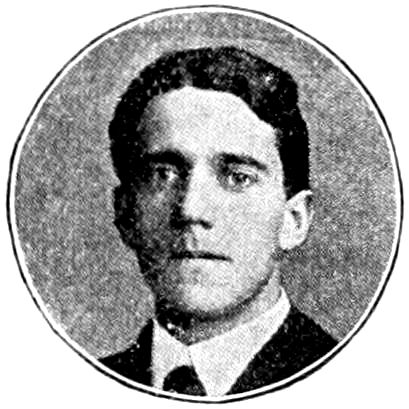
A well known authority on skating, rowing, boxing, racquets, and other athletic sports; was sporting editor of American Press Association, New York; dramatic editor; is a lawyer and has served several terms as a member of Assembly of the Legislature of the State of New York; has written several novels and historical works.
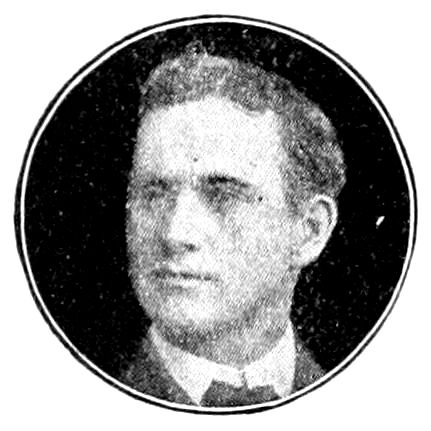
A resident of Chicago; the popularity of indoor base ball is chiefly due to his efforts; a player himself of no mean ability; a first-class organizer; he has followed the game of indoor base ball from its inception.
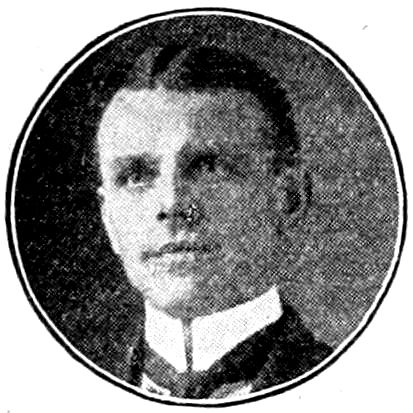
Has been connected with Yale University for years and is a recognized authority on gymnastics; is admitted to be one of the leading authorities in America on gymnastic subjects; is the author of many books on physical training.
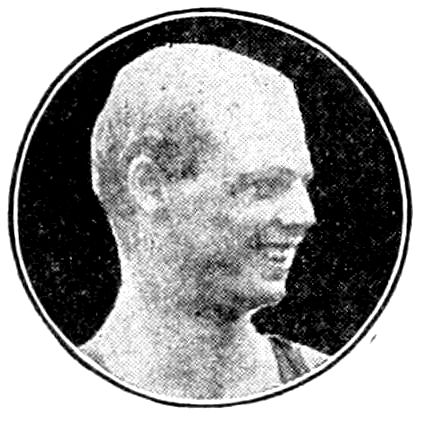
Just the man to write an authoritative book on swimming; the fastest swimmer the world has ever known; member New York Athletic Club swimming team and an Olympic champion at Athens in 1906 and London, 1908. In his book on Swimming, Champion Daniels describes just the methods one must use to become an expert swimmer.
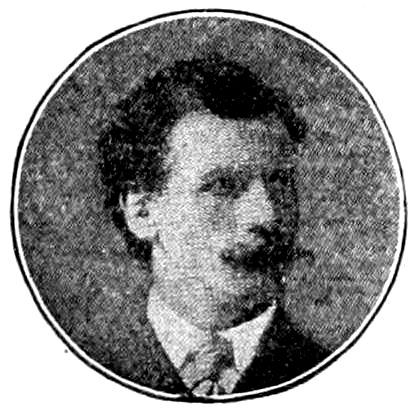
Mr. Bojus is most thoroughly qualified to write intelligently on all subjects pertaining to gymnastics and athletics; in his day one of America’s most famous amateur athletes; has competed successfully in gymnastics and many other sports for the New York Turn Verein; for twenty years he has been prominent in teaching gymnastics and athletics; was responsible for the famous gymnastic championship teams of Columbia University; now with the Jersey City high schools.
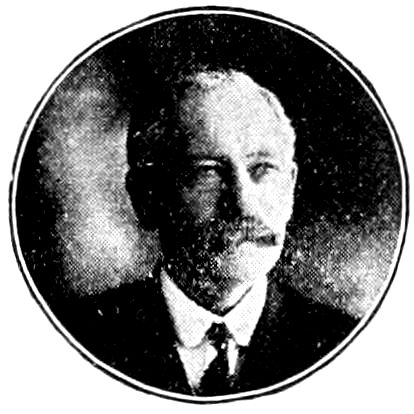
Admitted to be the “Father of Roque;” one of America’s most expert players, winning the Olympic Championship at St. Louis in 1904; an ardent supporter of the game and follows it minutely, and much of the success of roque is due to his untiring efforts; certainly there is no one better qualified to write on this subject than Mr. Jacobus.
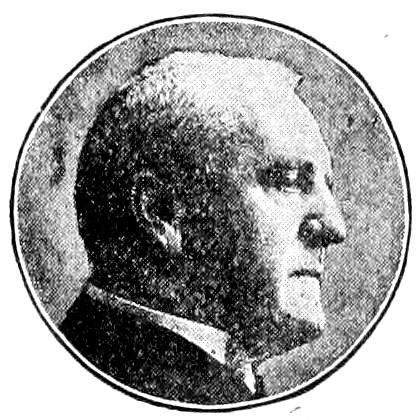
Well known as a physical training expert; was probably one of the first to enter the field and is the author of many books on the subject; lectures extensively each year all over the country.
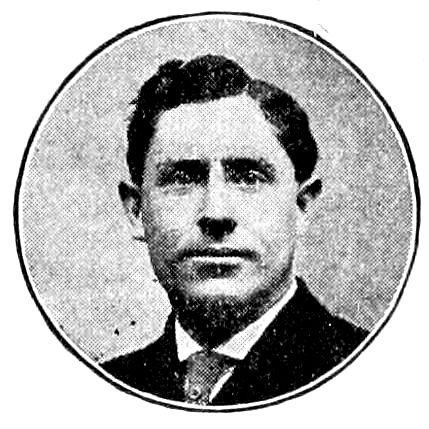
Now with the University of Pennsylvania; was formerly a Y. M. C. A. physical director; a keen student of all gymnastic matters; the author of many books on subjects pertaining to physical training.
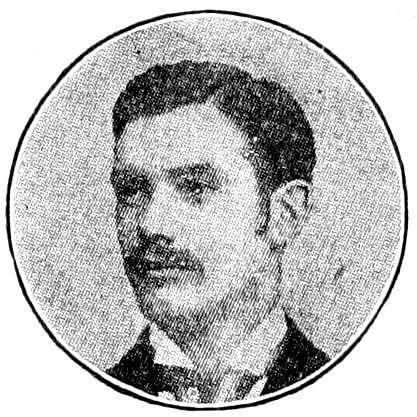
By profession a physical director of the Young Men’s Christian Association; a close student of all things gymnastic, and games for the classes in the gymnasium or clubs.
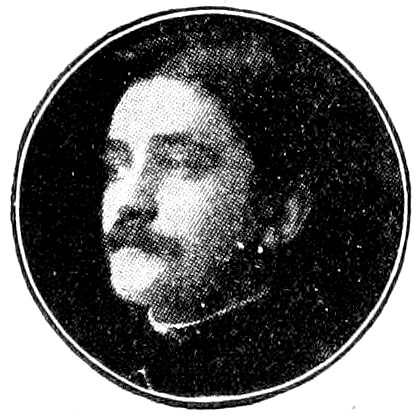
A leader in the fencing world; has maintained a fencing school in New York for years and developed a great many champions; understands the science of fencing thoroughly and the benefits to be derived therefrom.
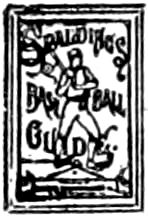
The leading Base Ball annual of the country, and the official authority of the game. Contains the official playing rules, with an explanatory index of the rules compiled by Mr. A. G. Spalding; pictures of all the teams in the National, American and minor leagues; reviews of the season; college Base Ball, and a great deal of interesting information. Price 10 cents.
Edited by Tim Murnane. New and revised edition. Illustrated with pictures showing how all the various curves and drops are thrown and portraits of leading players. Price 10 cents.
There is no better way of becoming a proficient batter than by reading this book and practising the directions. Numerous illustrations. Price 10 cents.
This book gives clear and concise directions for excelling as a base runner; tells when to run and when not to do so; how and when to slide; team work on the bases; in fact, every point of the game is thoroughly explained. Illustrated. Price 10 cents.
A new, up-to-date book. Its contents are the practical teaching of men who have reached the top as pitchers, and who know how to impart a knowledge of their art. All the big leagues’ pitchers are shown. Price 10 cents.
Every boy who has hopes of being a clever catcher should read how well-known players cover their position. Pictures of all the noted catchers in the big leagues. Price 10 cents.
Illustrated with pictures of all the prominent first basemen. Price 10 cents.
The ideas of the best second basemen have been incorporated in this book for the especial benefit of boys who want to know the fine points of play at this point of the diamond. Price 10 cents.
Third base is, in some respects, the most important of the infield. All the points explained. Price 10 cents.
Shortstop is one of the hardest positions on the infield to fill, and quick thought and quick action are necessary for a player who expects to make good as a shortstop. Illus. Price 10 cents.
An invaluable guide for the outfielder. Price 10 cents.
A useful guide. Price 10 cents.
To supply a demand for a book which would show the percentage of clubs without recourse to the arduous work of figuring, the publishers had these tables compiled by an expert. Price 10 cents.
Something new in Base Ball. Contains records of all kinds from the beginning of the National League and official averages of all professional organizations for past season. 10 cents.
The minors’ own guide. Edited by President T. H. Murnane, of the New England League. Price 10 cents.
Contains the Constitution, By-Laws, Official Rules, Averages, and schedule of the National League for the current year, together with list of club officers and reports of the annual meetings of the League. Price 10 cents.
This game is specially adapted for playgrounds, parks, etc., is spreading rapidly. The book contains a description of the game, rules and officers. Price 10 cents.
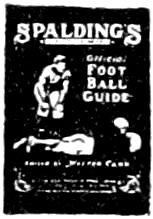
Edited by Walter Camp. Contains the new rules, with diagram of field; All-America teams as selected by the leading authorities; reviews of the game from various sections of the country; scores; pictures. Price 10 cents.
This book is meant for the use of Officials, to help them to refresh their memories before a game and to afford them a quick means of ascertaining a point during a game. It also gives a ready means of finding a rule in the Official Rule Book, and is of great help to a player in studying the Rules. Compiled by C. W. Short, Harvard, 1908. Price 10 cents.
Edited by Walter Camp, of Yale. Everything that a beginner wants to know and many points that an expert will be glad to learn. Snapshots of leading teams and players in action, with comments by Walter Camp. Price 10 cents.
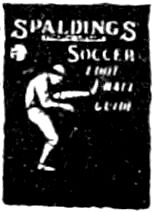
A complete and up-to-date guide to the “Soccer” game in the United States, containing instructions for playing the game, official rules, and interesting news from all parts of the country. Illustrated. Price 10 cents.
How each position should be played, written by the best player in England in his respective position, and illustrated with full-page photographs of players in action. Price 10 cents.
The official book of the game in Canada. Price 10 cents.
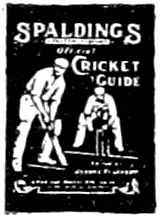
The most complete year book of the same that has ever been published in America. Reports of special matches, official rules and pictures of all the leading teams. Price 10 cents.
By Prince Ranjitsinhji. The game described concisely and illustrated with full-page pictures posed especially for this book. Price 10 cents.
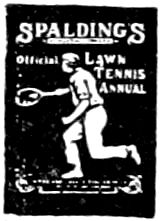
Contents include reports of all important tournaments; official ranking from 1885 to date; laws of lawn tennis; instructions for handicapping; decisions on doubtful points; management of tournaments; directory of clubs; laying out and keeping a court. Illustrated. Price 10 cents.
A complete description of lawn tennis; a lesson for beginners and directions telling how to make the most important strokes. Illustrated. Price 10 cents.
By P. A. Vaile, a leading authority on the game in Great Britain. Every stroke in the game is accurately illustrated and analyzed by the author. Price 10 cents.
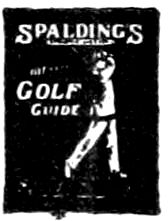
Contains records of all important tournaments, articles on the game in various sections of the country, pictures of prominent players, official playing rules and general items of interest. Price 10 cents.
By James Braid and Harry Vardon, the world’s two greatest players tell how they play the game, with numerous full-page pictures of them taken on the links. Price 10 cents.
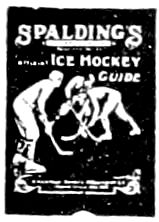
The official year book of the game. Contains the official rules, pictures of leading teams and players, records, review of the season, reports from different sections of the United States and Canada. Price 10 cents.
Contains a description of the duties of each player. Illustrated. Price 10 cents.
Prominent in the sports at Vassar, Smith, Wellesley, Bryn Mawr and other leading colleges. Price 10 cents.
Containing the rules for each game. Illustrated. Price 10 cents.
A new game for the gymnasium. Exciting as basket ball. Price 10 cents.
Contains the official rules of the Association, constitution, rules of competition, list of officers, and pictures of leading players. Price 10 cents.
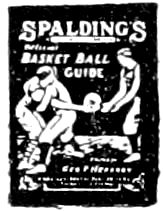
Edited by George T. Hepbron. Contains the revised official rules, decisions on disputed points, records of prominent teams, reports on the game from various parts of the country. Illustrated. Price 10 cents.
By G. T. Hepbron, editor of the Official Basket Ball Guide. Illustrated with scenes of action. Price 10 cents.
Edited by Miss Senda Berenson, of Smith College. Contains the official playing rules and special articles on the game by prominent authorities. Illustrated. Price 10 cents.
The official publication of the Collegiate Basket Ball Association. Contains the official rules, records, All-America selections, reviews, and pictures. Edited by H. A. Fisher, of Columbia. Price 10 cents.
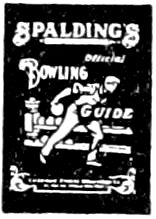
The contents include: diagrams of effective deliveries; hints to beginners; how to score; official rules; spares, how they are made: rules for cocked hat, quintet, cocked hat and feather, battle game, etc. Price 10 cents.
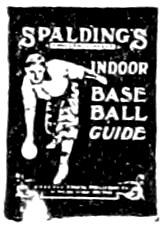
America’s national game is now vieing with other indoor games as a winter pastime. This book contains the playing rules, pictures of leading teams, and interesting articles on the game by leading authorities on the subject. Price 10 cents.
No. 10—Spalding’s Official Roller Polo Guide.
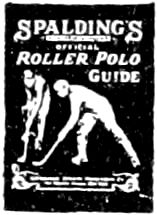
Edited by J. C. Morse. A full description of the game; official rules, records; pictures of prominent players. Price 10 cents.
The contents of this book treat of every detail, the individual work of the players, the practice of the team, how to throw the ball, with illustrations and many valuable hints. Price 10 cents.
Compiled by H. L. Fitzpatrick of the New York Sun. Illustrated with portraits of leading players, and contains most useful information for polo players. Price 10 cents.
Every position is thoroughly explained in a most simple and concise manner, rendering it the best manual of the game ever published. Illustrated with numerous snapshots of important plays. Price 10 cents.
Contains the constitution, by-laws, playing rules, list of officers and records of the association. Price 10 cents.
No. 271—Spalding’s Official Roque Guide.
The official publication of the National Roque Association of America. Contains a description of the courts and their construction, diagrams, illustrations, rules and valuable information. Price 10 cents.
Contains directions for playing, diagrams of important strokes, description of grounds, instructions for the beginner, terms used in the game, and the official playing rules. Price 10 cents.
A new and up-to-date book on this fascinating pastime. The several varieties of archery; instructions for shooting; how to select implements; how to score; and a great deal of interesting information. Illustrated. Price 10 cents.
How to play each game is thoroughly explained, and all the difficult strokes shown by special photographs taken especially for this book. Contains the official rules for each game. Price 10 cents.
Contains a description of the plays used by experts and the official rules. Illustrated. Price 10 cents.
This book contains the official rules and a sketch of the game; illustrated. Price 10 cents.
By the world’s champion, Michael Egan. Every play is thoroughly explained by text and diagram. Illustrated. Price 10 cents.
A short history of this famous Scottish pastime, with instructions for play, rules of the game, definitions of terms and diagrams of different shots. Price 10 cents.
How to construct a green; how to play the game, and the official rules of the Scottish Bowling Association. Illustrated. Price 10 cents.
These games are intended for use at recesses, and all but the team games have been adapted to large classes. Suitable for children from three to eight years, and include a great variety. Price 10 cents.
Lawn Hockey, Garden Hockey, Hand Tennis, Tether Tennis; also Volley Ball, Parlor Hockey, Badminton, Basket Goal. Price 10 cents.
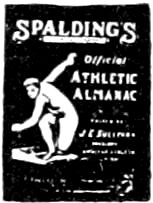
Compiled by J. E. Sullivan, President of the Amateur Athletic Union. The only annual publication now issued that contains a complete list of amateur best-on-records; intercollegiate, swimming, interscholastic. English, Irish, Scotch, Swedish, Continental, South African, Australasian; numerous photos of individual athletes and leading athletic teams. Price 10 cents.
M. C. Murphy, the well-known athletic trainer, now with Pennsylvania, the author of this book, has written it especially for the schoolboy and college man, but it is invaluable for the athlete who wishes to excel in any branch of athletic sport; profusely illustrated. Price 10 cents.
Gives in full the method of scoring the All-Around Championship; how to train for the All-Around Championship. Illustrated. Price 10 cents.
Full instructions for the beginner, telling how to sprint, hurdle, jump and throw weights, general hints on training; valuable advice to beginners and important A. A. U. rules and their explanations, while the pictures comprise many scenes of champions in action. Price 10 cents.
A complete account of the Olympic Games of 1906, at Athens, the greatest International Athletic Contest ever held. Compiled by J. E. Sullivan, Special United States Commissioner to the Olympic Games. Price 10 cents.
Edited by J. E. Sullivan. President of the Amateur Athletic Union. Tells how to organize an athletic club, how to conduct an athletic meeting, and gives rules for the government of athletic meetings; contents also include directions for laying out athletic grounds, and a very instructive article on training. Price 10 cents.
Every athlete who aspires to be a sprinter can study this book to advantage. Price 10 cents.
By J. W. Morton, the noted British champion. Many of Mr. Morton’s methods of training are novel to American athletes, but his success is the best tribute to their worth. Illustrated. Price 10 cents.
By George Orton, the famous University of Pennsylvania runner. The quarter, half, mile, the longer distances, and cross-country running and steeplechasing, with instructions for training; pictures of leading athletes in action, with comments by the editor. Price 10 cents.
Probably no other man in the world has had the varied and long experience of James S. Mitchel, the author, in the weight throwing department of athletics. The book gives valuable information not only for the novice, but for the expert as well. Price 10 cents.
By Geo. W. Orton. Each event in the Intercollegiate programme is treated of separately. Price 10 cents.
Contains rules not found in other publications for the government of many sports; rules for wrestling, shuffleboard, snowshoeing, professional racing, pigeon shooting, dog racing, pistol and revolver shooting, British water polo rules, Rugby foot ball rules. Price 10 cents.
The A. A. U. is the governing body of athletes in the United States of America, and all games must be held under its rules, which are exclusively published in this handbook, and a copy should be in the hands of every athlete and every club officer in America. Also includes a very interesting article on “The Growth of American Athletics,” and a short biography of each member of the Board of Governors. Price 10 cents.
Contains constitution, by-laws, and laws of athletics; records from 1876 to date. Price 10 cents.
Contains the Association’s records, constitution and by-laws and other information. Price 10 cents.
Contains the official rules governing all sports under the jurisdiction of the Y. M. C. A., official Y. M. C. A. scoring tables, pentathlon rules, pictures of leading Y. M. C. A. athletes. Price 10 cents.
Edited by Dr. C. Ward Crampton, director of physical education in the Public Schools of Greater New York. Illustrated. Price 10 cents.
The official publication. Contains: constitution and by-laws, list of officers. donors, founders, life and annual members, reports and illustrations. Price 10 cents.
By J. E. Sullivan. President Amateur Athletic Union and member of Board of Education of Greater New York. An invaluable handbook for the teacher and the pupil. Gives a systematic plan for conducting school athletic contests and instructs how to prepare for the various events. Illustrated. Price 10 cents.
A new and up-to-date book on this popular pastime. Contains pictures of the leading Marathon runners, methods of training, and best times made in various Marathon events. Price 10 cents.
Will interest the expert as well as the novice; the illustrations were made from photographs especially posed, showing the swimmer in clear water; a valuable feature is the series of “land drill” exercises for the beginner. Price 10 cents.
By E. J. Giannini, of the New York Athletic Club, one of America’s most famous amateur oarsmen and champions. Shows how to hold the oars, the finish of the stroke and other valuable information. Price 10 cents.
By Champion C. M. Daniels of the New York Athletic Club team, holder of numerous American records, and the best swimmer in America qualified to write on the subject. Any boy should be able to increase his speed in the water after reading Champion Daniels’ instructions on the subject. Price 10 cents.
Paddling, sailing, cruising and racing canoes and their uses; with hints on rig and management; the choice of a canoe; sailing canoes, racing regulations; canoeing and camping. Fully illustrated. Price 10 cents.
Contains advice for beginners; how to become a figure skater, showing how to do all the different tricks of the best figure skaters. Pictures of prominent skaters and numerous diagrams. Price 10 cents.
Directions for becoming a fancy and trick roller skater, and rules for roller skating. Pictures of prominent trick skaters in action. Price 10 cents.
Gives methods of the best riders when training for long or short distance races; hints on training. Revised and up-to-date in every particular. Price 10 cents.
Catch-as-catch-can style. Seventy illustrations of the different holds, photographed especially and so described that anybody can with little effort learn every one. Price 10 cents.
By Dr. Edward Breck. of Boston, editor of The Swordsman, a prominent amateur fencer. A book that has stood the test of time, and is universally acknowledged to be a standard work. Illustrated. Price 10 cents.
Contains over 70 pages of illustrations showing all the latest blows, posed especially for this book under the supervision of a well-known instructor of boxing, who makes a specialty of teaching and knows how to impart his knowledge. Price 10 cents.
By Regis and Louis Senac, of New York, famous instructors and leading authorities on the subject. Gives in detail how every move should be made. Price 10 cents.
The most complete and up-to-date book on wrestling ever published. Edited by F. R. Toombs, and devoted principally to special poses and illustrations by George Hackenschmidt, the “Russian Lion.” Price 10 cents.
Any boy. by reading this book and following the instructions, can become proficient. Price 10 cents.
Specially compiled for amateurs by Dr. James T. Gwathmey. Every variety of the pastime explained by text and pictures, over 100 different positions being shown. Price 10 cents.
The best treatise on bag punching that has ever been printed. Every variety of blow used in training is shown and explained, with a chapter on fancy bag punching by a well-known theatrical bag puncher. Price 10 cents.
By America’s amateur champion club swinger, J. H. Dougherty. It is clearly illustrated, by which any novice can become an expert. Price 10 cents.
The best work on dumb-bells that has ever been offered. By Prof. G. Bojus, of New York. Contains 200 photographs. Should be in the hands of every teacher and pupil of physical culture, and is invaluable for home exercise. Price 10 cents.
A series of plain and practical exercises with the medicine ball, suitable for boys and girls, business and professional men, in and out of gymnasium. Price 10 cents.
By Dr. Henry S. Anderson, instructor In heavy gymnastics Yale gymnasium. In conjunction with a chest machine anyone with this book can become perfectly developed. Price 10 cents.
Each move thoroughly explained and illustrated with numerous full-page pictures of Messrs. A. Minami and K. Koyama, two of the most famous exponents of the art of Jiu Jitsu, who posed especially for this book. Price 10 cents.
By Prof. E. B. Warman. By following the directions carefully anyone can become an expert. Price 10 cents.
A book devoted to the catch-as-catch-can style; illustrated with half-tone pictures showing the different holds used by Frank Gotch. champion catch-as-catch-can wrestler of the world. Posed by Dr. Roller and Charles Postl. By Ed. W. Smith, Sporting Editor of the Chicago American. Price 10 cents.
By G. M. Martin. A book that should be in the hands of every physical director of the Y. M. C. A., school, club, college, etc. Price 10 cents.
For years it has been the custom in most gymnasiums of memorizing a set drill, which was never varied. Consequently the beginner was given the same kind and amount as the older member. With a view to giving uniformity the present treatise is attempted. Price 10 cents.
Edited by Dr. R. Tait McKenzie, Director Physical Training, University of Pennsylvania. Profusely illustrated. Price 10 cents.
A book that will prove valuable to indoor and outdoor gymnasiums, schools, outings and gatherings where there are a number to be amused. Price 10 cents.
By Robert Stoll, of the New York A. C., the American champion on the flying rings from 1885 to 1892. Any boy can easily become proficient with a little practice. Price 10 cents.
All concede that games and recreative exercises during the adolescent period are preferable to set drills and monotonous movements. These drills, while designed primarily for boys, can be used successfully with girls and men and women. Profusely illustrated. Price 10 cents.
By W. J. Cromie, Instructor of Gymnastics. University of Pennsylvania. With illustrations showing many different combinations. This book should be in the hands of all gymnasium instructors. Price 10 Cents.
By W. J. Cromie. Every gymnast should procure a copy of this book. Illustrated with cuts showing many novel exercises. Price 10 cents.
By W. J. Cromie. Illustrated with half-tone photographs showing many interesting combinations. Price 10 cents.
Edited by P. R. Carpenter, Physical Director Amherst College. Contains pictures of leading teams and individual champions, official rules governing contests, records. Price 10 cents.
By Dr. Luther Halsey Gulick, Director of Physical Training in the New York Public Schools. A concise and complete course of physical education. Price 10 cents.
This is the fifth of the Physical Training series, by Prof. E. B. Warman (see Nos. 142, 149, 166, 185, 213, 261, 290.) Price 10 cents.
A book that all who value health should read and follow its instructions. By Prof. E. B. Warman, the well-known lecturer and authority on physical culture. Price 10 cents.
By Prof. E. B. Warman. A complete, thorough and practical book where the whole man is considered—brain and body. Price 10 cents.
By Prof. E. B. Warman. Health influenced by insulation; health influenced by underwear; health influenced by color; exercise. Price 10 cents.
By Prof. E. B. Warman. Contents: ventilating a bedroom; ventilating a house; how to obtain pure air; bathing; salt water baths at home; a substitute for ice water; to cure insomnia, etc., etc. Price 10 cents.
By Dr. L. H. Gulick, Director of Physical Training in the New York Public Schools. A complete treatise on the correct method of acquiring strength. Illustrated. Price 10 cents.
A series of drills for the use of schools. Edited by Dr. Luther Halsey Gulick. Director of Physical Training in the New York Public Schools. Price 10 cents.
By Prof. E. B. Warman. The “Tensing” or “Resisting” system of muscular exercises is the most thorough, the most complete, the most satisfactory, and the most fascinating of systems. Price 10 cents.
With hints on right living. By W. J. Cromie. If one will practice the exercises and observe the hints therein contained, he will be amply repaid for so doing. Price 10 cents.
By W. J. Cromie. If the hints therein contained are observed and the exercises faithfully performed great relief will be experienced. Price 10 cents.
By Prof. E. B. Warman. author of a number of books in the Spalding Athletic Library on physical training. Price 10 cents.
By Prof. E. B. Warman, with chapters on “How to Avoid Growing Old,” and “Fasting; Its Objects and Benefits.” Price 10 cents.
Edited by G. R. Borden. Physical Director of the Y. M. C. A., Easton, Pa. A book that is for practical work in the school room, Illustrated. Price 10 cents.
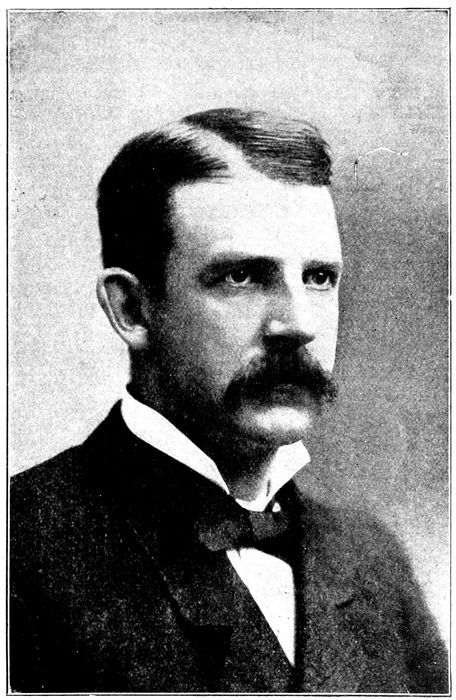
A. G. SPALDING
From Photograph Taken in San Francisco in November, 1879
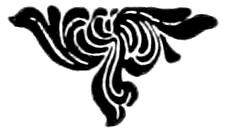
Teachers, especially in public gymnasia, where the attendance is voluntary, will welcome anything that will make the exercises more attractive and do away, as far as possible, with the idea of “work.”
Tumbling should form a part of every system taught in our public gymnasia, and to those who have not heretofore studied the subject we submit the following propositions:
1. Tumbling will develop, harmoniously, the whole body without the aid of any apparatus whatever, or any other set of exercises. A careful study of the physiques of professional tumblers will verify this statement.
2. The exercises can be easily graded, so that there will be absolutely no danger in going from primary to advanced tumbling. In individual tumbling, the body being always close to the ground, the chances of a break or a sprain are reduced to a minimum; and in comparison with other forms of exercise, such as boxing, wrestling, or apparatus work, the percentage of accidents will be found to compare most favorably.
3. Friends can enter into the keenest competition, urging each other to the highest possible development and perfection, and never experience the inconveniences of black eyes and bruises—the usual resultants of combative exercises.
4. At least 50 per cent. of those entering the gymnasium 4can participate in some form of tumbling, either individual or combination; the greatest progress for adults being attained in the latter, where two or more men exercise together.
5. No expensive appliances or apparatus is necessary in introducing or teaching tumbling, the mats absolutely essential in any gymnasium being all-sufficient for ordinary class work. But if tumbling is to be made a feature, then a large mat, 15 feet long by 6 feet wide and 2 feet high and stuffed with straw or hay, will be found a very attractive addition, as it can be used to great advantage with any gymnastic apparatus.
6. For boys, tumbling is the most natural exercise in the world, as they are easily interested and held in this form of exercise when a dumb-bell drill would run them away. Besides the development, they get co-ordination and control to a remarkable extent, which will be invaluable to them in any exercise that they may engage in later on.
7. A tumbler easily adapts himself to all gymnastic apparatus, and will usually be found to be more graceful than an exclusive apparatus worker. If teachers who have never used tumbling would introduce it, it would do away, in a great measure, with that stiffness which is so distasteful to many; and, if as systematically taught as their apparatus work, would change the product of their gymnasiums from the top-heavy type to a symmetrical whole.
8. It is the one universal exercise used by the whole human family from the earliest times to the dawn of the twentieth century, and will continue in use as long as the world lasts. The millions of babies tumbling in the world to-day, learning 5their first physical exercise—to walk—reminds us that we have all taken a few lessons, at least, in this most useful art.
9. Tumbling is of more importance than all other exercises, as, nolens volens, we all take a tumble occasionally; and if we know how to tumble—so as to land on our feet or keep from falling—it will give us a confidence that we would not otherwise have. There seems to be a very prevalent idea that if a man has never learned how to tumble before he is twenty-one he had just as well not start. On the contrary, if a person has never taken gymnastic exercises, he can make greater advancement in tumbling than in almost any other form of exercise, if his physique permits of tumbling at all. After acquiring a few of the exercises, tumbling can be practiced with pleasure and satisfaction on any lawn, sand-bar, or sawdust pile, and in this way will prove of more practical utility than almost any form of gymnastics.
A word of caution might not be out of place: In teaching adults (where a large mat, such as already described, is not used) the small mats cannot be piled too high to prevent jars and shocking surprises. If pupils suffer from dizziness, excuse them from these exercises. In combination tumbling the belt, or lunger, must always be put on for a first trial, however simple the exercise may appear.
In the following pages I have depended almost entirely upon the illustrations, and have intentionally made the text as short and concise as possible—following the plan of Messrs. Hitchcock and Nelligan’s most excellent work, “Wrestling.” I am also indebted to Dr. William Anderson, of Yale University, for many valuable suggestions.
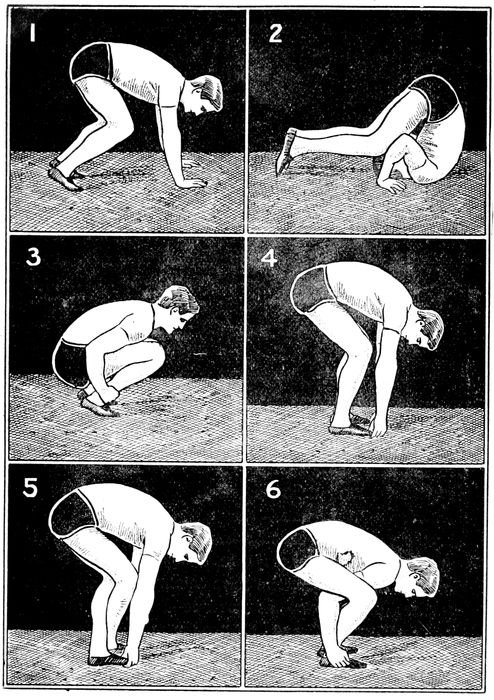
1. The Forward Roll Over. Double up close, and finish standing erect on toes. Figs. 1, 2, 3.
2. The Forward Roll Over, grasping toes throughout roll. Fig. 4.
3. The Forward Roll Over, grasping toes, legs crossed Fig. 5.
4. The Forward Roll Over, arms between legs, hands on outside of ankles. Fig. 6.
5. The Forward Roll Over, arms between legs, hands clasped. Fig. 7.
6. The Forward Roll Over, arms at side horizontal throughout exercise. Do not touch mat with hands. Commence standing on right foot, swing the left to front to get momentum, and then under and back as you roll over to erect position on right foot again. Figs. 8, 9, 10, 11.
7. The Forward Roll Over. Same as No. 6, starting on left foot.
8. The Forward Roll Over. To lying flat on back.
9. The Forward Roll Over, with half-turn to face downward.
10. The Forward Roll Over, feet spread, arms in different positions.
11. The Forward Roll Over, arms folded, come to standing position.
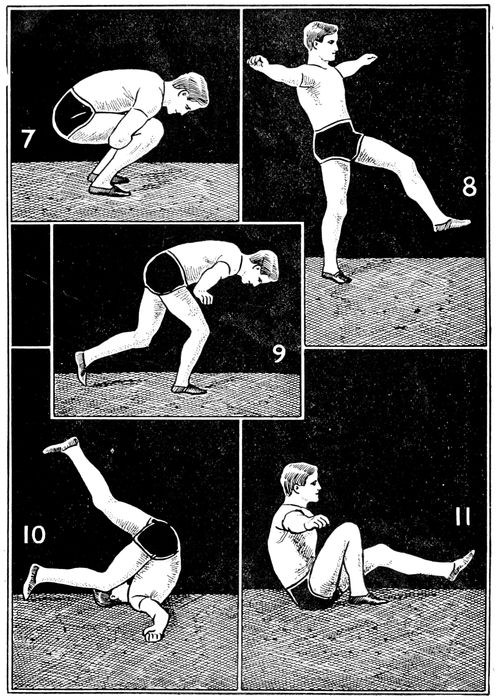
912. The Backward Roll Over. Repeat all of the foregoing backwards.
13. A Dive is a jump for height or distance, alighting on hands. Bend arms, duck head, and forward roll over. Never strike middle of back first. Commence with the forward roll over (Figs. 1, 2, 3), and gradually increase the height or distance until you can finally go your full limit without jolting or bumping yourself in the least. The rise is usually from both feet.
14. Dive (1) for distance, (2) for height.
15. Combine the Forward Roll Over and Dive for (1) Distance, (2) for Height.
16. Fall Forward without Bending at Hips, with knees stiff; catch on hands.
17. Fall Backward, stiff (stage fall).
18. Fall Forward, with chest out, and back arched. Turn head to right or left. Continue rolling, and push over to feet.
19. Combine Front and Back Roll Over, making continuous movement by crossing legs as you finish the front roll.
20. Combine Back and Front Roll Over.
21. Combine Front, Back, and Front Roll Over in quick succession.
22. Combine Back, Front, and Back Roll Over in quick succession.
23. Roll Over Backward, straightening body as you go over to lying-down position on stomach.
24. Lie on back, arms at side horizontal. Bring right hand close to side, turn head to right, and at same time bend at waist, bringing feet over head, then snap over quickly on to stomach, facing in opposite direction.
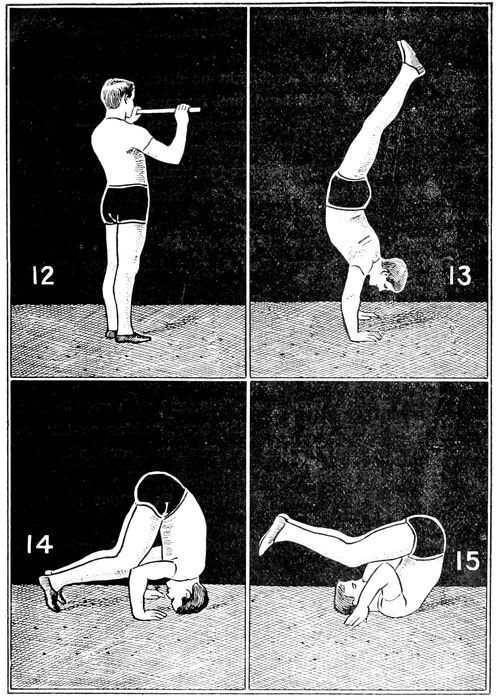
1125. Hold left toe with right hand and jump right leg through.
26. Hold right toe with left hand and jump left leg through.
27. Hold stick in hands, jump through and back in order to learn to double up close for back or forward somersault. Fig. 12.
28. Head Stand. Place the hands in line on the mat, and the head between and about 10 inches in advance, forming an equilateral triangle; throw feet over head, with knees together and toes pointed upward; hold 30 seconds, then forward roll over.
20. Hand Stand. Beginners can best learn this by placing the hands on floor 1½ feet from wall and throwing the feet up against the wall. In practising hand stands on the floor, come down easy to feet the same way you threw into position, or pick up right or left hand as you overbalance and come to feet, or bend arms and roll over. Fig. 13.
30. Head Stand. Push up into hand stand without losing balance.
31. Forward Roll Over into Head Stand.
32. Backward Roll Over into Head Stand.
N. B.—Do not compete in holding head stands for time. Caution boys especially against this foolish practice.
33. “Bucking Broncho.” Throw almost into hand stand, bend knees and push up hard with hands, throwing head and shoulders up and back, snap feet to floor and come to standing position; jump to hands again and repeat.
34. The Forward Roll Over into Hand Stand.
35. The Backward Roll Over into Hand Stand.
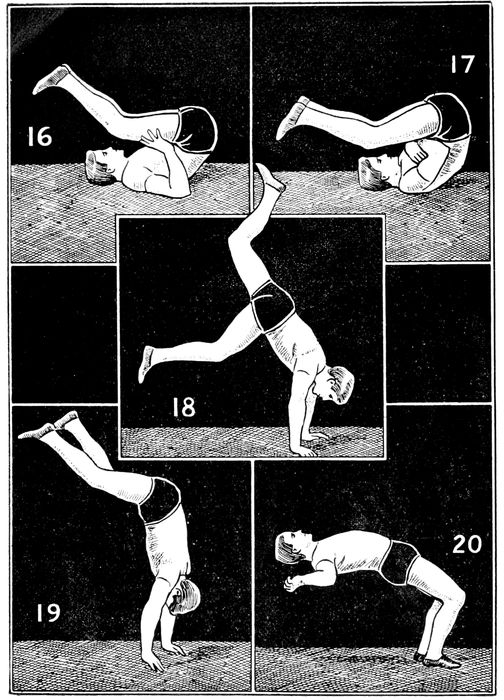
1336. Body stiff, face downward, resting on hands and feet, without raising either hand, jump between hands to lying-down position on back.
37. Roll Down. From hand stand incline head and shoulders forward, bend arms until chest touches, keep back arched, roll to lying-down position on mat, then to knees, and jump to feet immediately.
38. Head Stand and Roll Down.
39. Lie on back, raise feet up in air, place the hands just above the hips, with elbows, upper arms and shoulders touching mat, bend and straighten knees with a snap, thus progressing backward on shoulders.
40. Head Spring. Place head (touching upper part of forehead, not the back of head) between and in advance of hands on mat. As you snap feet over shove hard from hands and head. Alight in standing position, with knees bent. Fig. 14.
N. B.—Always place head on mat easily, thus obviating jars.
41. Same as No. 40, only alighting knees stiff and back arched.
42. Same as No. 40, without hands.
43. Repeat No. 40, alight on right foot, and hold balance.
44. Repeat No. 40, alight on left foot, and hold balance.
45. Twisting Head Spring. Same as No. 40, only twist the body to right or left, and land facing starting position.
46. The Balance Head Spring. From head stand bend at waist, with knees stiff, execute head spring without touching feet to floor.
47. Same as No. 46, but with neck spring.
48. Neck Spring (snap up). Place back of head and neck on mat between hands. Same movement as head spring. Fig. 15.
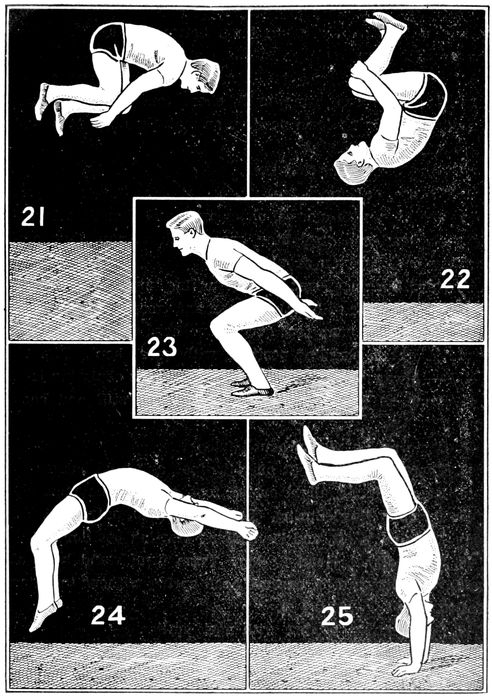
1549. Neck Spring. Hands on front of thighs, shove hard with hands and head as you snap feet over. Fig. 16.
50. Neck Spring with arms folded. Fig. 17.
51. Hand Spring. Jump from either foot on to hands. Keep the arms perfectly stiff, and as the feet are thrown quickly over (chest and stomach well out and head back) shove hard from hands and alight on feet with bent knees. Figs. 18, 20.
52. Leaping Hand Spring. Jump from both feet on to hands. Movement same as in 51. Touch hands lightly as you go over. Figs. 19, 20.
53. Same as 51, only alight on balls of feet, with knees stiff, back arched, and perfectly erect position.
54. The Cart-wheel. Either right or left side leading, keep the head back, chest and stomach well out, hands and feet as well separated as possible. If right side leads, place right hand on floor following with left, then left foot followed by right. Continue movement by keeping in a straight line.
55. Round Off. Start as in cart-wheel, but hand spring movement, turn, snap the feet down quickly, and alight facing starting-point.
56. Roll over backward to back of neck and snap up.
57. Jump, turn in air, alight facing starting-point, and back roll over.
58. Combine hand stand (Fig. 13) and snap up (Fig. 15).
59. A row of hand stands and snap ups in quick succession.
60. Combine two, three, or four head springs in quick succession.
61. Combine two, three, or four neck springs in quick succession.
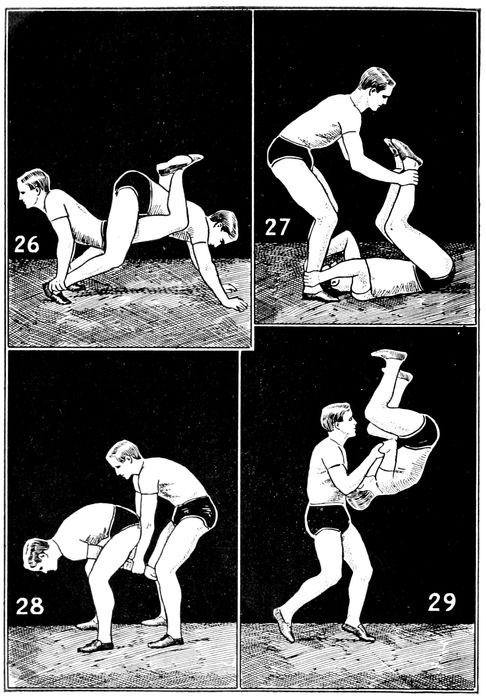
1762. Alternate Head and Neck Springs in quick succession.
63. Hand Walk. Throw up into hand stand, and as you overbalance take a step forward with either right or left hand, and continue.
64. Hand Walk Forward.
65. Hand Walk Backward.
66. Hand Walk in Circle.
67. Hand walk forward, turn, and come back to starting-point.
68. Hand walk forward, touching chest at each step.
69. Hand walk, forward roll into hand stand, and repeat.
70. Two head springs into hand stand, roll down (37), pull through (36), and snap up (48).
71. Dive, back roll into hand stand, to neck, and snap up.
The combinations of the foregoing movements are infinite, and the inventive teacher can repeat the same exercises in a different order or combination, making new movements out of the old ones, and thus keeping up the interest and enthusiasm from day to day. Select ten or twelve movements from the preceding list, and give as a drill for one lesson. Change the order, and repeat for next lesson; but give an entirely different drill for third lesson. As the pupils advance let them put in their own combinations at the end of each lesson.
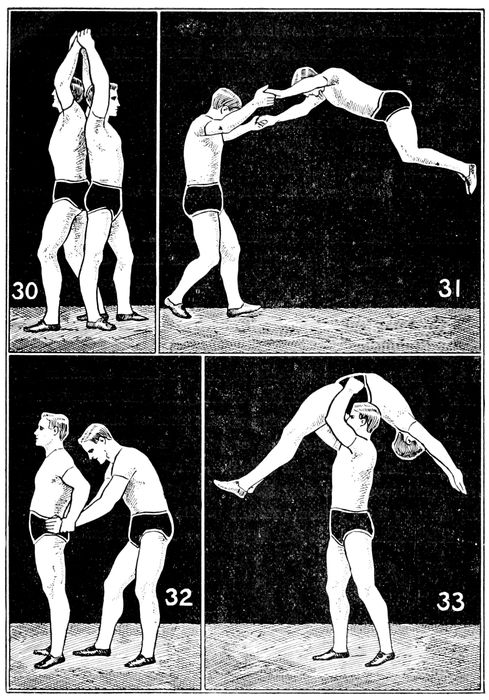
Note.—Advanced tumbling should never be attempted alone the first time. A belt, with an assistant on either side, is the usual method of practising these exercises. Do not hurry. Practise one movement day after day until you are proficient, remembering that a difficult movement once mastered is as simple as any other, and that after learning you can execute them with ease and impunity. It is folly, not bravery, to attempt movements by yourself that you are not sure of; and you are the one to decide this, not others.
1. Back Somersault. From standing position, hands by the side, spring straight up (do not bend forward as you stoop for spring), throwing hands high above head; throw the head back, and, grasping the knees, pull them well in at the highest point of jump, at the same time kicking the feet forward; let out, and come down straight. Fig. 21.
2. From a hand stand snap to feet and a back somersault.
3. Round off and a back somersault.
4. Two, three, or four back somersaults in a swing.
5. Forward run and back somersault.
6. Cart-wheel, round off, and back.
7. Front Somersault. Run forward, and as you run increase your speed; spring from either right or left foot a distance of from 8 to 12 feet, landing on the balls of both feet, hands by the side (Fig. 70), chest out, and head erect (not forward); jump for height, lifting the body by a quick upward swing of the arms, and at the highest point of the jump throw head and hands down with a snap, grasp the legs a short distance below the knees and pull in close and hard, doubling up close, then straighten out quickly and alight on balls of feet in erect position. Fig. 22.
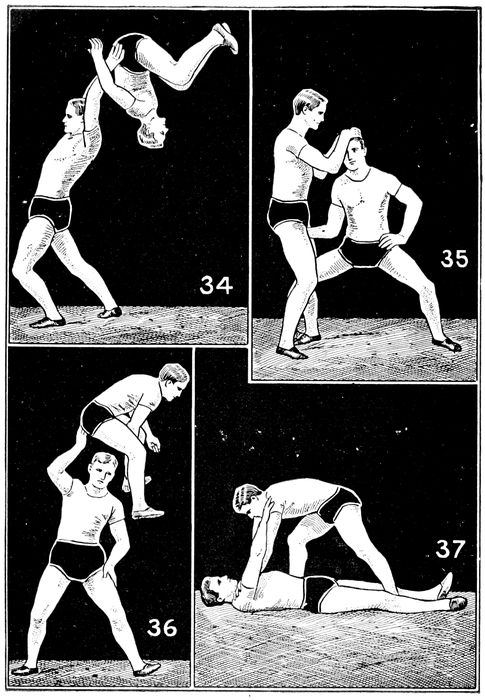
21Note.—Make the jump for height the fastest part of the run, and as you jump increase your speed so as to get the greatest height attainable, double into as small a ball as possible, and then let out and come down perfectly straight, and you have the ideal somersault.
8. Standing Front Somersault. Hands by the sides (Fig. 70), spring straight upward, lifting with arms and shoulders, and as you reach the limit of your height throw head and hands forward with a snap, grasping ankles and pulling in close; then let out again quickly.
9. The Layout Front Somersault. (Done principally from the spring-board, although a few exceptionally fine jumpers can do it from the mat.) As you rise for the somersault throw the hands well out in front, with arms perfectly stiff, head up, chest out; hold this position for a second, then make a quick, close double as in the ordinary somersault; let out and come down straight.
10. One Foot Front. Stand on one foot and execute regular somersault.
11. Knee Front. From kneeling position raise to feet, regular somersault.
12. Head Spring and Front Somersault.
13. Hand Spring and Front Somersault.
14. Two Front Somersaults in Quick Succession.
N. B.—A double somersault should never be attempted by amateurs.
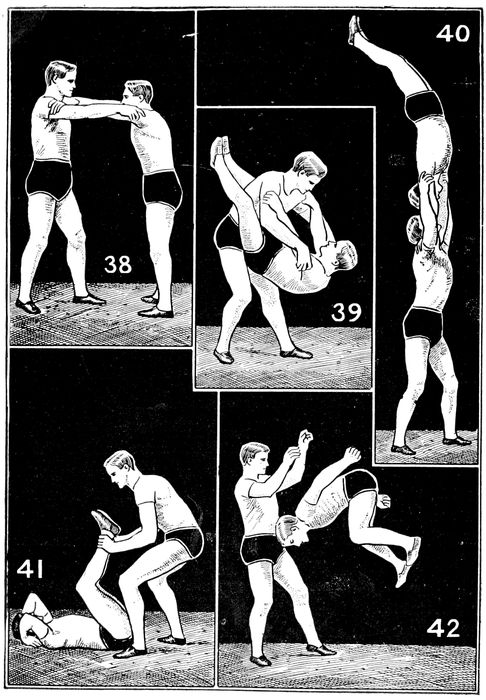
2315. Back Hand Spring, or “Flip” (the most difficult of all tumbling exercises). From standing position raise the heels, bend the knees, let the hands go back past sides, keep the body, from waist up, straight, stoop until hands can nearly touch the mat; from this position throw the hands swiftly forward and upward, at the same time raise on toes (but do not jump at all), arching the back well in, head and arms thrown as far back as possible; pull the body over by momentum of shoulders, body, and head. Figs. 23, 24, 25.
16. Hand Stand, Snap to Feet, and Flip.
17. Hand Stand, Snap to Feet, Flip, and Back.
18. A Row of Flips; Two or More in Quick Succession.
19. Alternate Flips and Backs.
20. Round Off and Flip.
21. Round Off, Flip, and Back.
22. Twisting Flip. As the hands hit, twist the body and alight facing in opposite direction from which you started.
23. A Series of Twisting Flips. The hands strike about the same place each time.
24. Twisting Back. Regular movement, only throw head hard to right or left and alight facing opposite direction from which you started. Fig. 74.
25. Hand Stand, Snap to Feet, and Twisting Flip.
26. Round Off and Twisting Back.
27. Running Twisting Forward Somersault. Regular movement, only throw head hard to right or left, and alight facing direction from which you started.
28. Running Side Somersault. Alight sideways and turn sideways.
Devise, invent, and make up your own combinations.
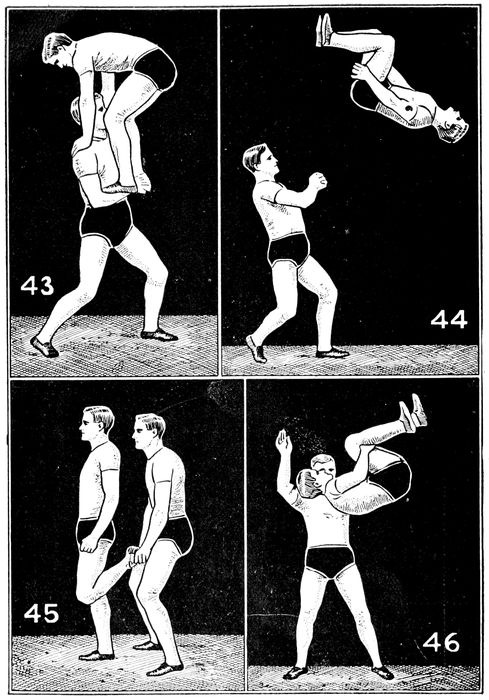
By this is meant a series of combinations by two or more men exercising together. In these exercises a belt must always be put on for the first trial (or assistants stand on either side), however simple the exercises may appear, and must be kept on until the exercise is thoroughly mastered, which would mean that you have each other’s time and act in unison. Work with the same men all the time; beware of strangers, even if both of you understand the exercises. Do not be afraid to use caution and common sense. Only combinations that can be mastered by business men with limited time have been put in; the more dangerous ones, requiring much time, being intentionally omitted. In all of the following exercises No. 1 is the heaviest or “bottom” man; No. 2, “middle” man; and No. 3, “top” man (or lightest man).
1. Stand facing each other. No. 2 puts hands on No. 1’s shoulders, springs up and throws legs around No. 1’s waist, then leans backward and drops between No. 1’s legs, who then bends forward and places hands on floor keeping knees stiff; No. 2 places hands on No. 1’s heels and straightens arms; No. 1 then walks off (also with a small boy on top), or untwists legs and both do a roll over. Fig. 26.
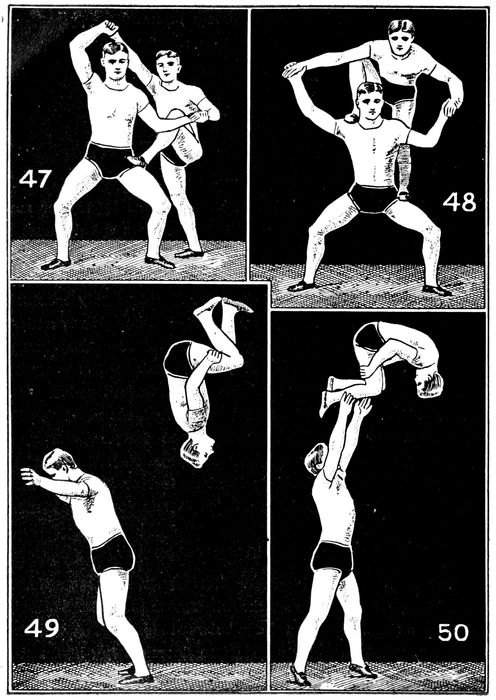
2. No. 2 makes hand stand, feet well apart; No. 1 steps in, letting legs rest on hips, and grasps heels of No. 2, who straightens himself, arms folded; No. 1 then walks off with him. For first part of movement see Fig. 96.
3. No. 1 stands erect; No. 2 makes hand stand close to No. 1’s heels, his legs dropping over No. 1’s shoulders, who grasps No. 2’s ankles, bends forward, quickly pulling No. 2 over to a standing position; No. 1 now does a hand stand and is thrown over by No. 2. Repeat in quick succession. For first part of movement see Fig. 99.
4. No. 1 lies on back, legs raised to vertical, with knees slightly bent, and grasps No. 2’s ankles, who stands close to his head and also grasps No. 1’s ankles; No. 2 dives forward, held back slightly by No. 1 to break his fall; continue roll. Fig. 27.
5. Repeat No. 4 backward.
6. Facing same direction, No. 2 leans forward and places his arms between his own legs; his wrists are grasped by No. 1, who lifts (as No. 2 jumps) and throws him over to his feet. Figs. 28, 29.
7. Stand back to back, arms extended vertically, grasp each other’s hands, heads turned to opposite sides; No. 2 springs and No. 1 pulls No. 2 over shoulders to feet. No. 2 must never relax muscles on this exercise. Figs. 30, 31.
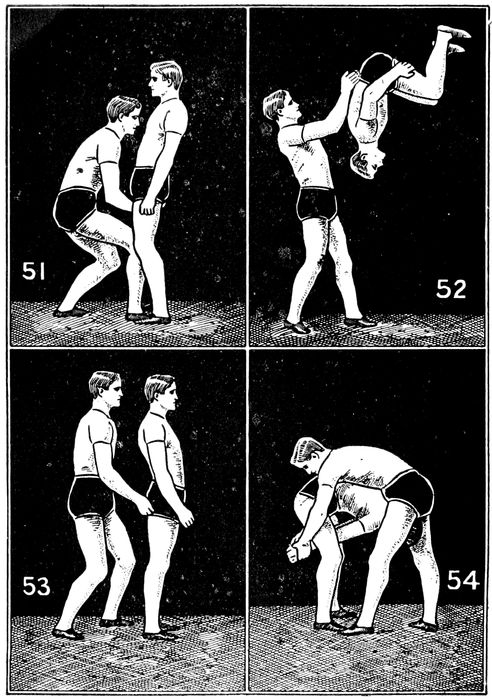
8. Facing in same direction, No. 1 grasps No. 2 on either side of belt, and No. 2 grasps No. 1’s wrists and springs up, assisted by No. 1 lifting, and comes to balance position on No. 1’s head; No. 2 then throws his head back, pulls legs up and snaps over to feet, assisted by a slight push from No. 1. Figs. 32, 33.
9. Same as No. 8, only in quicker time. No. 2 does not touch head of No. 1, who holds his arms perfectly stiff, and throws No. 2 over his head in one movement. Fig. 34.
10. Leap-frog, roll over, and continue.
11. No. 1 places one hand under No. 2’s crotch; No. 2 places both hands on No. 1’s head and vaults over. Figs. 35, 36.
12a. No. 2 lies down and No. 1 places foot close up and between No. 2’s legs and grasps both hands of No. 2, who springs up and straddle vaults over, while No. 1 pulls, then pushes his hands to horizontal with quarter turn of body.
12b. Position and first part of movement same as No. 12a, only No. 1 grasps No. 2’s wrists; as No. 2 passes over No. 1’s head, he doubles up close and does a hand spring from No. 1’s hands.
13. No. 1 lies on back, feet apart; No. 2 steps in and, bending forward, they place hands on each other’s shoulders; No. 2 does hand stand, No. 1 holding him in position. Fig. 37.
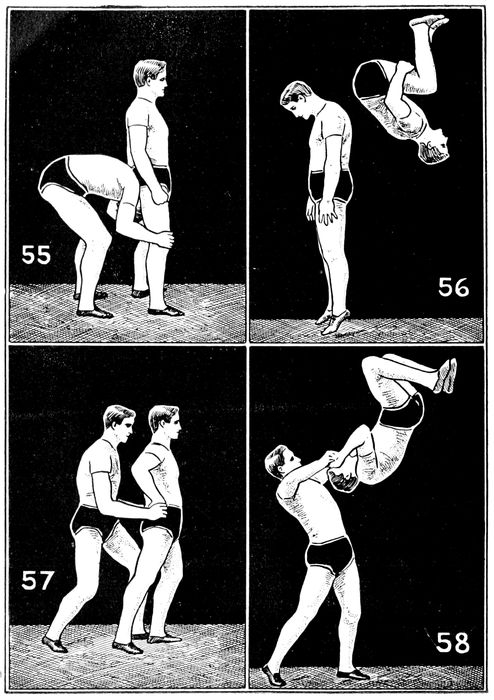
14. Facing each other, hands on shoulders, No. 2 jumps up, crossing feet behind back of No. 1, who leans over and immediately comes to erect position; No. 2 pushing up into high arm stand. Figs. 38, 39, 40.
15. Repeat No. 13. No. 2 is let down easily by No. 1, and rolls over, retaining hold on each other’s shoulders, to lying down position on backs; No. 1 does a quick back roll, and lands on feet between No. 2’s spread legs, and immediately pulls No. 2 (who assists by jumping) to high hand to shoulder stand in air. Fig. 40.
16. From position of Fig. 39, No. 1 throws No. 2 hand spring over head.
17. Facing each other, and six feet apart, No. 2 dives halfway over, keeping palms of hands on mat by side of head, legs vertical; No. 1 grasps ankles and gives him a quick pull up and throw away; No. 2 assisting by pushing with his hands and head, and coming to standing position facing No. 1. Figs. 41, 42.
18. Same as No. 17, only both face same direction; No. 2 does forward roll; No. 1 pulls No. 2 to feet.
19. No. 1 stands body straight, feet spread, knees bent, and, interlacing fingers, holds forearms horizontal; No. 2 places hands on No. 1’s shoulders, jumps to forearms, and back somersaults off. Figs. 43, 44.
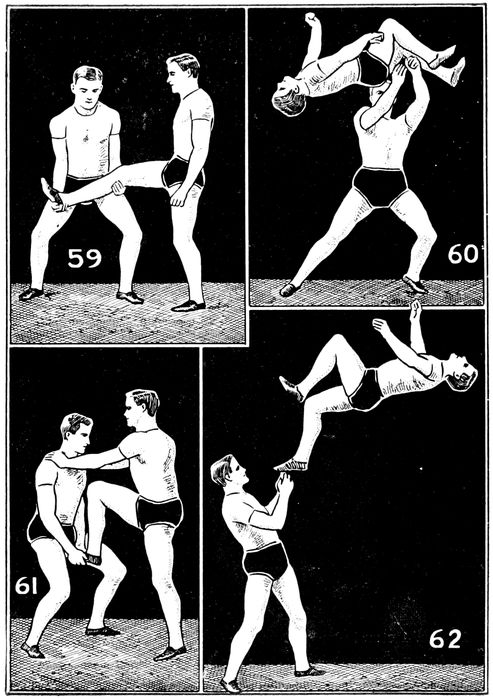
20. Facing same direction, one foot apart, No. 2 bends knee and places right or left ankle in No. 1’s hands; No. 2 jumps directly up (assisted by No. 1), cuts close, and does a high forward somersault, coming down straight. Figs. 45, 46.
21. No. 1 facing front, No. 2 to left of No. 1 and right face; No. 1 bends knees slightly, feet well apart, holds right hand over head, palm up, and grasps No. 2’s right hand, also No. 2’s left with his left hand; No. 2 places left foot on No. 1’s left thigh; as each pulls hard with right hand, No. 2 jumps and places his right foot on No. 1’s right shoulder and left on left shoulder, lets go of No. 1’s hands and stands erect, heels together on balls of feet, knees straight, and legs pressing hard on No. 1’s head. Figs. 47, 48.
22. Position same as in No. 21, only No. 1 folds arms; and No. 2, taking a short run, mounts to shoulders without using hands.
23. Facing in same direction, No. 1 grasps No. 2’s hands and lifts to shoulders, No. 2 doubling up close in order to bring his feet to No. 1’s shoulders. For first part of movement see Fig. 57.
24. No. 1 reaches up and grasps hands of No. 2, who jumps down between.
25. Both lean forward as far as possible; No. 2 jumps to feet, and both do a forward roll over.
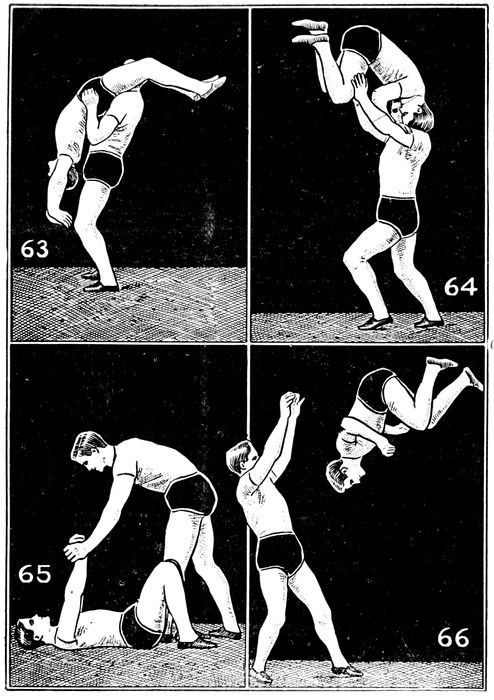
26. Mount as in No. 23; as No. 2 jumps, No. 1 assists by lifting hard. Fig. 49.
27. Mount as in No. 23; as No. 2 jumps, No. 1 assists by lifting hard. Fig. 50.
28. Facing each other, No. 1 places hands under No. 2’s crotch, and lifts hard; No. 2 doing a regular back somersault. Figs. 51, 52.
29. Facing in same direction. No. 1 grasps No. 2 by seat and lifts hard; No. 2 doing a regular front somersault. Fig. 53.
30. Facing each other, No. 2 leans forward, putting his hands between his own spread legs; No. 1 leans over and grasps No. 2’s wrists; a quick pull lands No. 2 on his shoulders straddle seat. He then places his hands under thighs of No. 2, who, in turn, does a back somersault off, assisted by a slight shove from No. 1. Fig. 54.
31. Same as No. 30, only No. 2 puts his feet on No. 1’s shoulders. Back or forward somersault off.
32. Position same as in Fig. 54. No. 1 grasps No. 2’s wrists, pulls him up, and places his hands on his shoulders; No. 2 continues movement by hand spring over.
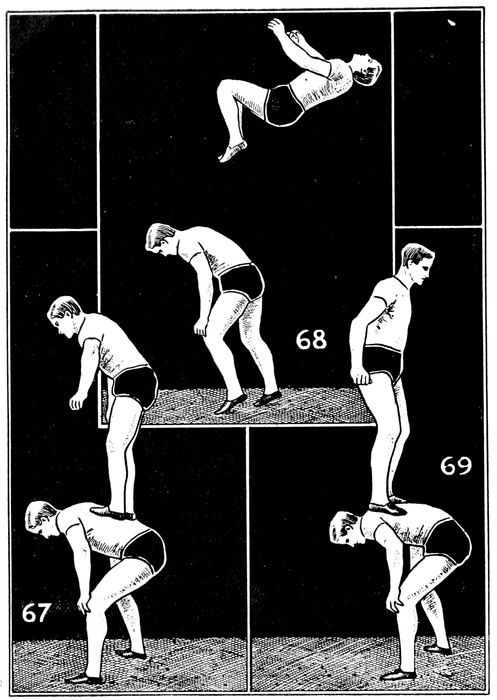
33. Facing same way, No. 1 puts head between legs of No. 2, who leans back quickly, and No. 1 straightens up and tosses him over his head; No. 2 doing back somersault movement. Figs. 55, 56.
34. Same as 33, only No. 2 throws head quickly to right or left, and alights with back to No. 1.
35. Facing, and 6 feet apart, No. 1 dives forward, and as his head rests on mat—that is, half way over—with feet well apart, No. 2 dives over, comes to feet quickly; each turns, and repeat movement.
36. No. 1 in middle and facing No. 2, No. 3 back of No. 1 and facing in same direction; No. 1 dives forward and No. 2 dives over No. 1 (as in No. 35); No. 3 immediately dives over No. 2, and No. 1 has turned and now dives over No. 3; No. 2 again dives over No. 1, and repeat as before.
37. Facing in same direction, No. 1 grasps No. 2’s hands and lifts him to standing position on shoulders; No. 2 jumps to mat between hands, and, without letting go, immediately jumps straight up, doubling up as he goes, stiffening arms and pressing hard against hands of No. 1, who pushes up, straightening arms; No. 2 continues on through, and does a hand spring from No. 1’s hands. Figs. 57, 58.
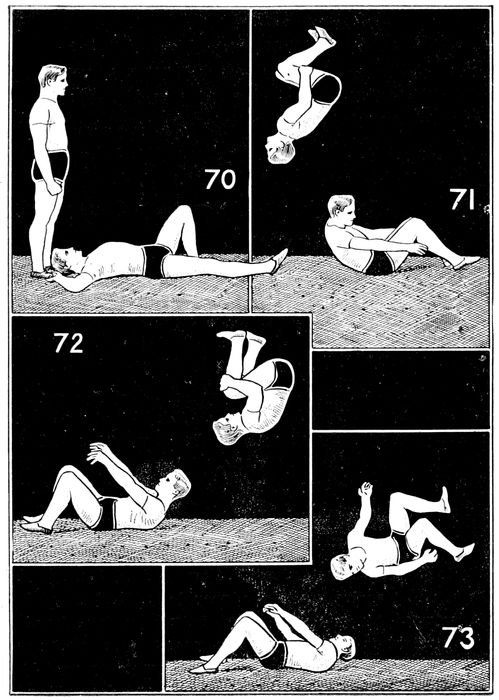
38. Position same as Fig. 57, only No. 1 rests right knee on mat; No. 2 jumps over No. 1’s right arm, and immediately back to first position, in same manner over left arm, then over head and back again; No. 1 now rises to feet immediately, No. 2 doing lift away hand spring as in No. 37.
39. Same as No. 37, only go straight from mat to hand spring without going to shoulders.
40. No. 2 places right leg in No. 1’s hands, leg horizontal, knee stiff; as No. 2 jumps and presses down with right leg No. 1 lifts hard, throwing him a back somersault. Figs. 59, 60.
41. No. 1 interlaces fingers, palms up, and stoops well down, feet spread; No. 2 places hands on shoulders (also without placing hands on shoulders) and right foot in his hands, jumps, straightening right leg, and does a hollow back somersault, No. 1 lifting up hard. Figs. 61, 62.
42. Same as No. 41, only No. 1 places hands behind back instead of in front.
43. Same as No. 41, only No. 2 turns over No. 1’s head, alighting on opposite side from which he started.
44. Position of No. 1 same as in No. 41; No. 2 runs, placing hands on No. 1’s shoulders, and right foot in hands, jumps, straightening right leg, and goes for regular front somersault, alighting with back to No. 1.
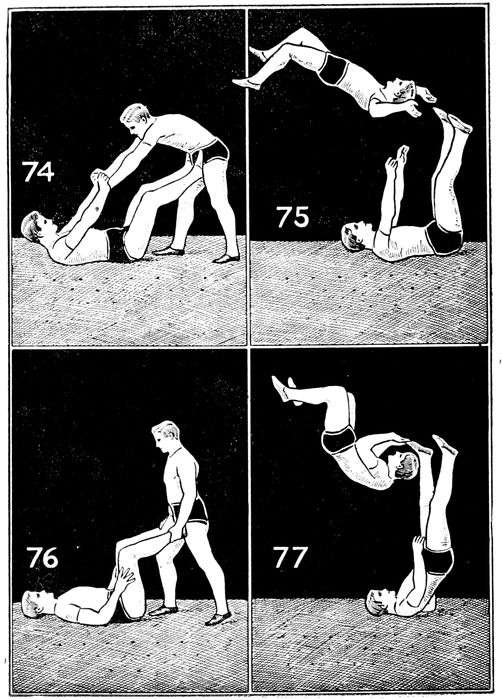
45. Facing each other, No. 1 bends knees slightly; No. 2 takes a run and places hands on No. 1’s knees and does a hand spring up, assisted by No. 1 grasping him by hips. Now quick roll back from shoulders. Fig. 63.
46. No. 1 spreads feet and braces himself, bending knees and getting low; No. 2 takes a good run, places hands on shoulders of No. 1, who grasps his thighs and pushes him over for a hand spring. Fig. 64.
47. Facing each other, and 6 feet apart, No. 2 rolls over and pushes his feet well up under him; No. 1 steps in, grasping No. 2’s hands, pulls him up, and then pushes him up and away; No. 2, doubling up close, pushing hard with hands, throws head back and goes for back somersault. Figs. 65, 66.
48. Facing in same direction, No. 1 bends over, placing hands on knees; No. 2 jumps to back, between shoulders, and does a back off, No. 1 lifting up hard. Figs. 67, 68.
49. Facing each other, and about 20 feet apart, No. 1 stoops over, placing hands on knees; No. 2 runs and jumps on No. 1’s back, between shoulders, and immediately goes for front somersault, as from spring-board, No. 1 throwing hard. Fig. 69.
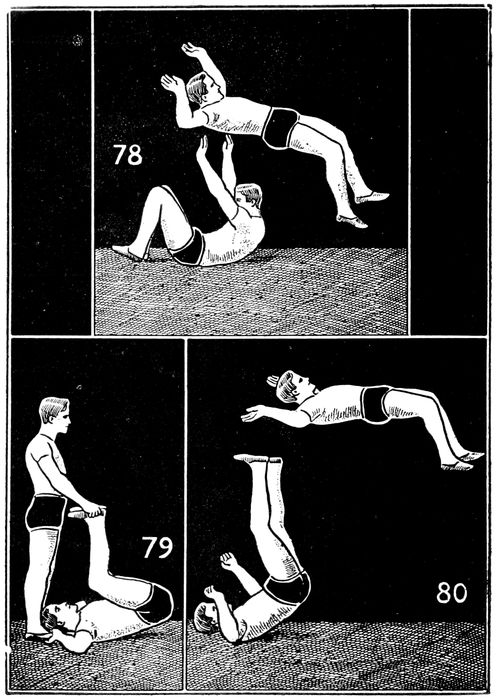
50. Lift to shoulders, as in No. 23. From position of Fig. 91, No. 2 throws into hand stand.
51a. No. 1 lying on back, hands close to head; No. 2 steps in No. 1’s hands and does a back somersault, assisted by No. 1. Figs. 70, 71.
51b. Same as No. 51, only No. 2 takes a few steps and jumps in No. 1’s hands, going for back immediately.
52. No. 1 sits on floor, feet spread, and places hands in front, palms up; No. 2 steps in hands as before, and back out.
53. No. 2 places toes in No. 1’s hands, and does a regular front, assisted by No. 1. Fig. 72.
54. Same as No. 51, only No. 2 twists completely around by turning head to right or left as he goes over, and alights facing in opposite direction from which he started. Fig. 73.
55. Clasp hands (do not interlace fingers), No. 1 placing feet on No. 2’s body, No. 2 jumps, and No. 1 pushes hard with feet and keeps his arms stiff, No. 2 pushing off with hands as he goes over. Figs. 74, 75.
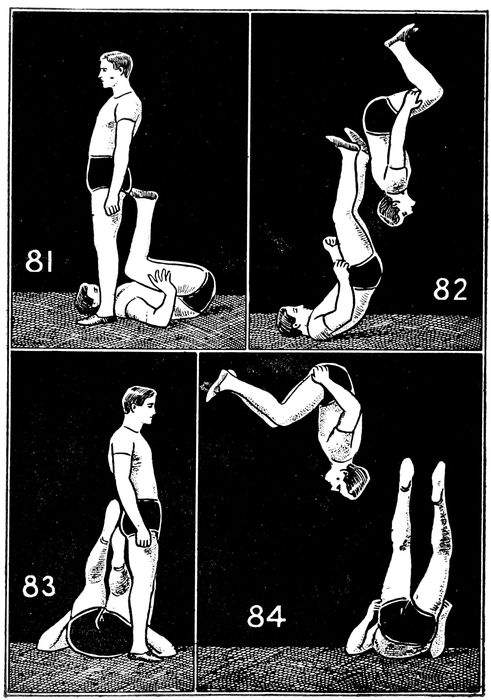
56. No. 2 grasps No. 1’s ankles and places feet against his body, same as in No. 55; No. 2 shoves hard from ankles as he goes over, keeping arms stiff in last part of movement, No. 1 also holding his legs stiff in last part of movement. Figs. 76, 77.
57. No. 2 runs and places hands on No. 1’s knees and hand spring over, No. 1 shoving his shoulders, if necessary, as he goes over. Fig. 78.
58. No. 2 steps in No. 1’s hands and grasps the bottoms of feet of No. 1, who holds legs stiff while No. 2 does hand spring over. Figs. 79, 80.
59. Standing close to No. 1’s shoulders, No. 2 sits on his feet, leans back, and No. 1 pushes up hard; No. 2 doubles up for regular back. Figs. 81, 82.
60. Same as No. 59, only No. 2 throws head quickly to right or left and alights with back to No. 1.
61. No. 2 stands by side of No. 1, and sits on feet. Rest of movement same as in No. 59. Figs. 83, 84.
62. No. 2 sits on No. 1’s feet and lays back; No. 1 kicks vigorously, No. 2 doing regular back movement, and landing away from No. 1 on same side from which he started, not turning over No. 1 at all. Figs. 85, 86.
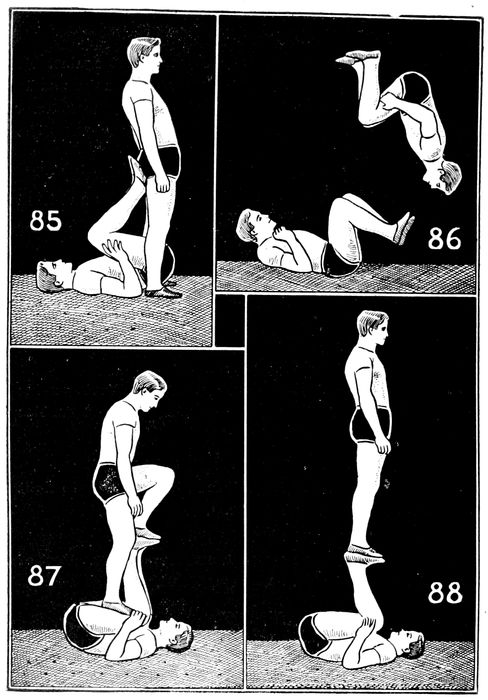
63. No. 2 jumps on No. 1’s feet, gets a perfect balance, and does a back off.
64. No. 1 lies on back, feet up, hands on outside of thighs; No. 2 places right foot on No. 1’s left thigh, and presses inside of knee against No. 1’s foot to steady himself. He then places left foot on No. 1’s left foot and, without touching hands, comes to an erect position, then back somersault off. Figs. 87, 88.
65. Facing each other, No. 1 places hands on knees, bending over so that elbows project above back; No. 2 runs, places hands on elbows, and hand spring over. Figs. 89, 90.
66. Mount to shoulders as in No. 23, then hand spring off. Figs. 91, 92.
67. Facing in same direction, No. 1 in front, No. 2 rolls to position on back, arms folded, and straightens knees so that his feet can be grasped by No. 1, who pulls him through quickly on to feet. Fig. 93.
68. Facing each other, No. 1 places head between No. 2’s legs and, grasping his knees, straightens up, throwing No. 2 over his head, who assists movement by placing his hands on No. 1’s hips and pushing off hard, elbows stiff. Fig. 94.
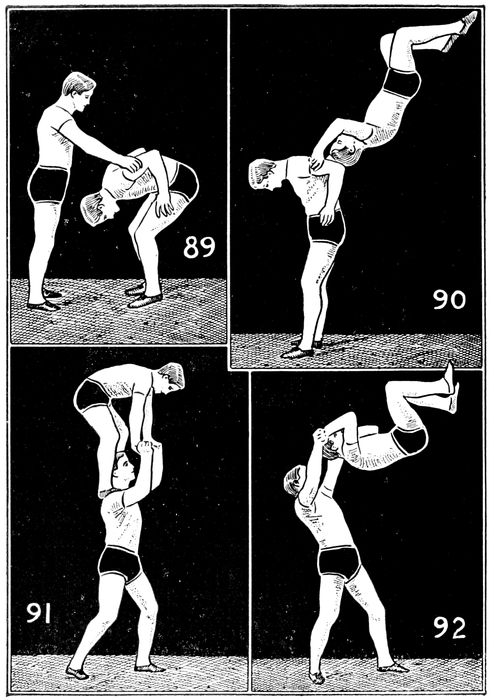
69. No. 1 does a hand stand and roll down; No. 2 stands over him, feet on either side of thighs. No. 2 jumps on No. 1’s back thighs and immediately jumps straight up, No. 1 coming to hands and knees, and No. 2 lands on No. 1’s back just above hips; No. 2 again jumps straight up, and No. 1 comes to feet with hands on knees; No. 2 jumps up again, No. 1 comes to an erect position, and No. 2 lands on shoulders. Lean and roll over.
70. Complete jump to shoulders as in No. 69; No. 1 bends and places right knee and then left on mat, now crosses feet and sits down, straightening legs out in front, then lies down, still holding and steadying No. 2 by ankles, who retains his erect position by standing on front of No. 1’s shoulders; No. 1 brings legs up, feet well apart, and No. 2 steps on his right or left hock and mashes it down; No. 1 turns head to right or left and continues back roll, coming to hands and knees; No. 2 steps up immediately on his back and does two jumps to shoulders (lean and roll over, or back or forward somersault off).
71. Get into position as in No. 2; No. 1 presses hard on heels of No. 2, who comes up quickly and continues movement by rolling on over No. 1’s back. Figs. 95, 96.
72. No. 2 does a hand stand, and his ankles are grasped by No. 1, who stoops over quickly and assists No. 2 in turning the front somersault after leaving his shoulders, by pushing up hard on No. 2’s ankles (called a double—the body only turns once and a half). Figs. 97, 98, 99.
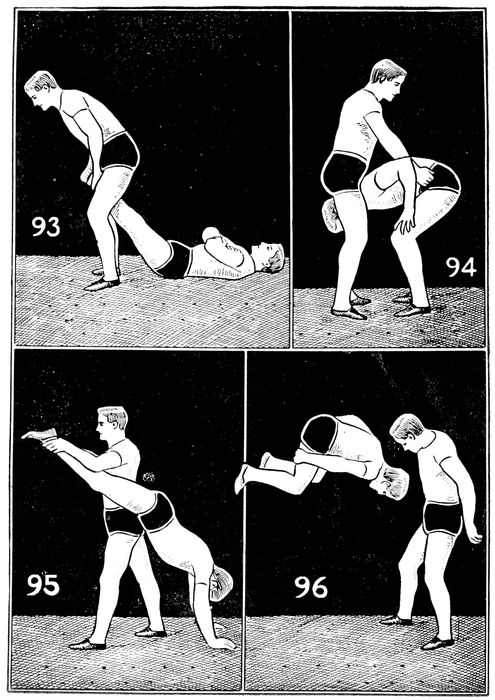
73. Same as No. 4, only three men grasp each other’s ankles and roll forward. Fig. 100.
74. Facing each other, No. 1 squats, No. 2 placing hands on No. 1’s shoulders; No. 2 jumps on his thighs, No. 1 catching him by calves; No. 2 does a back, assisted by No. 1 lifting and raising up. Fig. 101.
75. Facing in same direction, No. 1 stoops, and placing his head under No. 2’s crotch lifts to shoulders, stoops and places No. 2’s feet on his thighs (or No. 1 grasps No. 2’s hands and lifts to thighs) and grasps his ankles; No. 2 straightens up and No. 1 pulls his head out, and as No. 2 jumps for his forward No. 1 assists by raising up and lifting hard with hands. Fig. 102.
76. From this position either a back or front somersault can be easily thrown. No. 1 grasps his left wrist with right hand; No. 2, same; each then grasps the other’s right wrist with left hand, thus forming basket. Fig. 103.
77. No. 2 lifts No. 3 on shoulders, No. 1 then lifts No. 2 (and No. 3), No. 3 straightens up and leans forward, No. 2 pulls head out and holds No. 3 in position by ankles, No. 2 now raises up slightly and leans forward and No. 1 pulls head out and, straightening up, completes the knee three high. No. 3 jumps down and rolls over, followed by No. 2 and No. 1 in quick succession. Figs. 104, 105, 106.
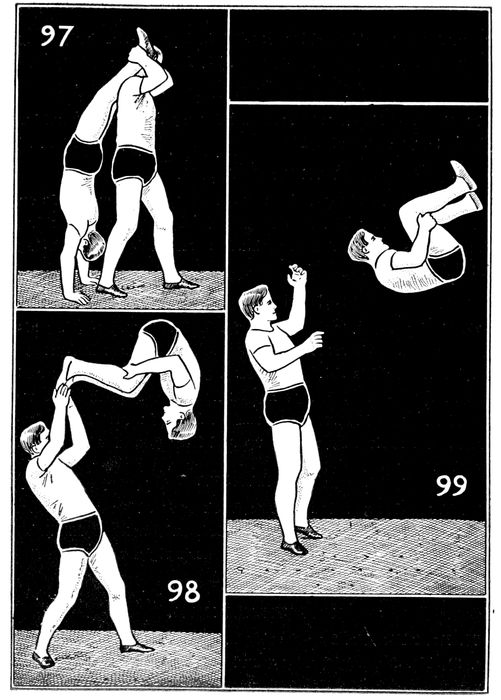
78. Build three high as in No. 77. No. 3 does a front off, then No. 2, and No. 1 does a standing front. Fig. 107.
79. (The object is for No. 2 to mount to shoulders without moving No. 1 from his tracks. This should first be practiced a number of times on the floor, and then on top of the horse or buck. When practicing a three high the top mount should always have around his waist a belt suspended from the ceiling the first few trials.) Facing each other and clasping hands, No. 1 pulls No. 2 (who jumps) on his feet, hands above head; No. 2 places left hand on top of No. 1’s head, and clasps his right hand; No. 2 bends left leg and places his foot in No. 1’s left hand; No. 1 pulls hard with right hand and lifts with left, No. 2 assisting himself by pressing hard on No. 1’s head with left hand; No. 2 places right foot on No. 1’s right shoulder and left foot on left shoulder, and comes to an erect position. Figs. 108, 109, 110.
80. No. 2 mounts to No. 1’s shoulders and grasps No. 3’s hands (Fig. 111) and pulls him to top of No. 1’s shoulders; No. 3 continues on up by still mount. Lean and fall. Fig. 112.
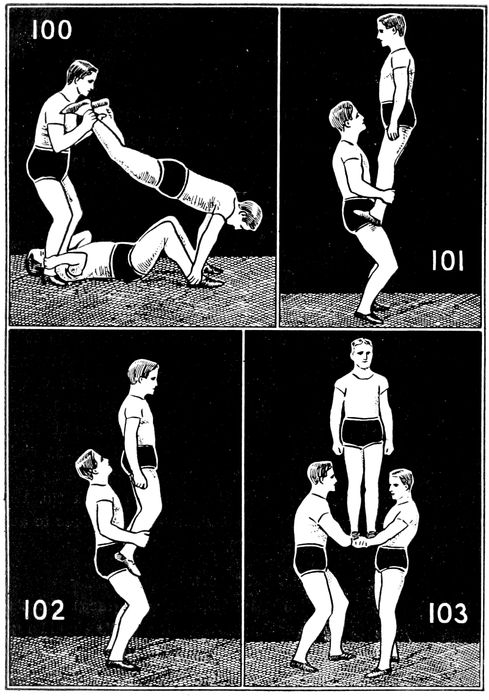
W. G. Anderson, Associate Director Yale University Gymnasium: “I believe in ‘tumbling’ as an exercise. It makes a man quick, agile, and very sure-footed. It is a form of sport that is popular and perfectly legitimate when properly taught. We have no good book on the subject, but need one. If such a work is to be presented to those interested in this subject, it ought to be written by a man who has had much experience in actual tumbling, who is familiar with the mechanism of the body, and who is educated. Dr. James T. Gwathmey, of Vanderbilt University, Nashville, Tenn., is just the person to compile a book on this form of gymnastics. He is a clever performer, a teacher of wide experience, and an educated physician. I have looked over the MS. of the Doctor’s new book, and I indorse it.”
R. Tait McKenzie, M.D.: “I am glad to find some one ready and able to draw the veil from a branch of gymnastics which the professional acrobat has so long kept shrouded in mystery. The reducing of the various feats of tumbling to a progressive sequence, and the analyzing of the various combinations, is indeed a difficult task; but your kinetoscope method of illustration will make clear what would otherwise require pages of description. Your work can not but assist any one of ordinary ability in mastering the rudiments of the art; but it will also appeal to the much wider field of all who admire acrobatics, and will give them some idea of the difficulties mastered by the professional, whose work they will more fully appreciate. I wish your book every success.”
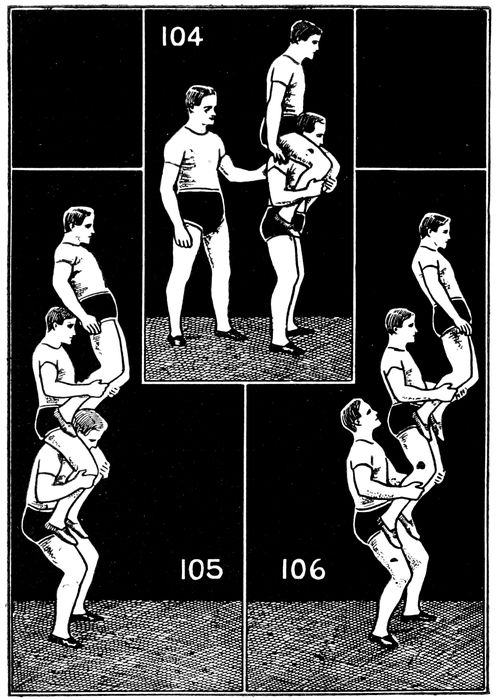
E. Hitchcock, Jr., M.D., Director of Department of Hygiene and Physical Training, Cornell University: “It has always seemed to me that this graphic method of instructing is the most useful, and I know that this subject in your hands will help enormously in instructing in a decidedly difficult branch of gymnastic work.”
E. Hitchcock, M.D., Amherst College, Pratt Gymnasium: “In physical education, as in many other branches of mental and bodily training, there are some advanced branches which are adapted to the few and not the many. Acrobatic work is one of these. But it should be controlled, cultivated, and made good use of, like the other work, which may be undertaken by anybody. It is a pleasure to know that a manual on this subject is to be prepared and furnished for our use by one so capable to issue the book as is Dr. Gwathmey, of Vanderbilt University. We shall wait impatiently to get hold of it.”
R. F. Nelligan, Instructor, Amherst College: “For sound men and boys tumbling is one of the best and most exhilarating of exercises, when practised under favorable conditions. Of course tumbling on a brick sidewalk differs from tumbling on a hair-stuffed mattress, with the aid of the safety appliances while learning. It has been said that one can not learn after reaching maturity. This is not so, as many first-class tumblers did not commence until after reaching twenty-five. At the age of thirty-two I was induced to take up tumbling under Dr. Gwathmey, and, with the aid of his safety appliances, succeeded in learning to do fairly well over fifty different movements and combinations.”
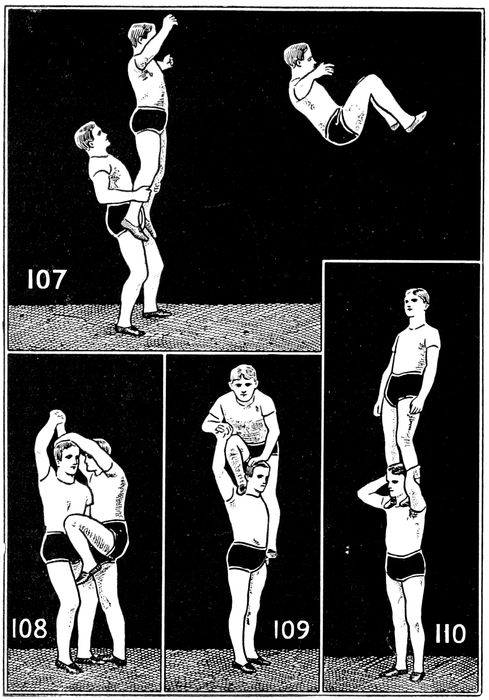
Carl Betz, Supervisor Music and Physical Training, Public Schools: “Your book, ‘Tumbling for Amateurs,’ which you have announced, will undoubtedly be hailed with delight by thousands of young American men who seek and find recreation in this particular kind of exercise. The photographs that will illuminate the pages of your book will be of intrinsic value to amateurs, who usually have no expert teacher to explain to them minutely each step of the exercise. If the element of danger in tumbling is greater than is consistent with the needs of physical education, as some claim it is, then your book, giving such minute instructions, and photographs of the body passing through the different stages of each exercise, cannot fail to reduce that danger to a degree which every interesting gymnastic exercise must contain. I therefore cheerfully recommend your interesting and timely little book to all who may wish to learn and practice the delightful pastime of tumbling.”
William A. Stecher, Secretary Technical Committee, Nord Amerikanischer Turnerbund: “I think that your undertaking is a very commendable one; for I believe that the greater the control a person has over his body—and tumbling undoubtedly increases this—the better off he is. I wish you all success.”
Frank Pfister, M.D., Editor Mind and Body: “Received your favor of the 7th inst., and congratulate you upon the idea of publishing a manual on tumbling, for nothing recommendable exists in that line.”
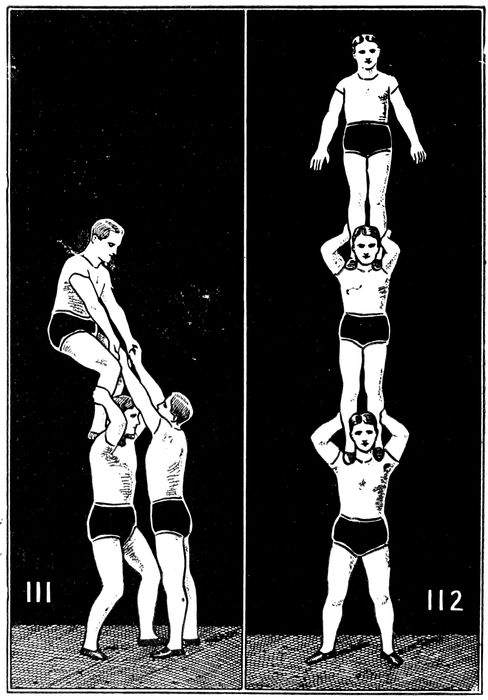
Luther Gulick, M.D. (“History of Physical Training”), International Y. M. C. A. Training-School: “Your letter of the 7th is at hand, with the excellent cuts that were inclosed. You ought not to charge less than one dollar for the book. I do not know but what you could get more. I shall be very glad to purchase a copy of the book as soon as it is published. Please let me know.”
G. W. Ehler, Physical Director of the Y. M. C. A. of Chicago, Central Department: “There is a necessity for a good book on tumbling, as there is none now in print to my knowledge; and I believe that such a book would meet with a very hearty reception by physical directors and by others who are interested.”
Robert J. Roberts: “I approve of your idea of getting out such a book as you speak of. I would keep out the dangerous exercises; or, if you put them in, hedge them in so that amateurs will not use them. There is no kind of physical work that will so harmoniously develop every part of the body as tumbling.”
The following list contains the Group and the Number of the book of Spalding’s Athletic Library in which the rules wanted are contained. See front pages of book for complete list of Spalding’s Athletic Library.
| Event. | Group | No. | |
|---|---|---|---|
| All-Round Athletic Championship | 12 | 182 | |
| A. A. U. Athletic Rules | 12 | 311 | |
| A. A. U. Boxing Rules | 12 | 311 | |
| A. A. U. Gymnastic Rules | 12 | 311 | |
| A. A. U. Water Polo Rules | 12 | 311 | |
| A. A. U. Wrestling Rules | 12 | 311 | |
| Archery | 11 | 248 | |
| Badminton | 11 | 188 | |
| Base Ball | 1 | 1 | |
| Indoor | 9 | 9 | |
| Basket Ball, Official | 7 | 7 | |
| Collegiate | 7 | 312 | |
| Women’s | 7 | 318 | |
| Water | 12 | 55 | |
| Basket Goal | 6 | 188 | |
| Bat Ball | 12 | 55 | |
| Betting | 12 | 55 | |
| Bowling | 8 | 8 | |
| Boxing—A. A. U., Marquis of Queensbury, London Prize Ring | 14 | 162 | |
| Broadsword (mounted) | 12 | 55 | |
| Caledonian Games | 12 | 55 | |
| Canoeing | 13 | 23 | |
| Children’s Games | 11 | 189 | |
| Court Tennis | 11 | 194 | |
| Cricket | 3 | 3 | |
| Croquet | 11 | 138 | |
| Curling | 11 | 14 | |
| Dog Racing | 12 | 55 | |
| Fencing | 14 | 165 | |
| Foot Ball | 2 | 2 | |
| Code of Rules | 2 | 334 | |
| Association (Soccer) | 2 | 2A | |
| English Rugby | 12 | 55 | |
| Canadian | 2 | 332 | |
| Golf | 5 | 5 | |
| Golf-Croquet | 6 | 188 | |
| Hand Ball | 11 | 13 | |
| Hand Polo | 10 | 188 | |
| Hand Tennis | 11 | 194 | |
| Hitch and Kick | 12 | 55 | |
| Hockey | 6 | 304 | |
| Ice | 6 | 6 | |
| Field | 6 | 154 | |
| Garden | 6 | 188 | |
| Lawn | 6 | 188 | |
| Parlor | 6 | 188 | |
| Ring | 12 | 55 | |
| Ontario Hockey Ass’n | 6 | 256 | |
| Indoor Base Ball | 9 | 9 | |
| Intercollegiate A. A. A. A. | 12 | 307 | |
| I.-C. Gymnastic Ass’n | 15 | 333 | |
| Lacrosse | 11 | 201 | |
| U. S. I.-C. Lacrosse League | 11 | 337 | |
| Lawn Bowls | 11 | 207 | |
| Lawn Games | 11 | 188 | |
| Lawn Tennis | 4 | 4 | |
| Obstacle Races | 12 | 55 | |
| Olympic Game Events—Marathon Race, Stone Throwing with Impetus, Spear Throwing, Hellenic Method of Throwing Discus. Discus, Greek Style for Youths | 12 | 55 | |
| Pigeon Flying | 12 | 55 | |
| Pin Ball | 12 | 55 | |
| Playground Ball | 1 | 306 | |
| Polo (Equestrian) | 10 | 199 | |
| Polo, Rugby | 12 | 55 | |
| Polo, Water (A. A. U.) | 12 | 311 | |
| Potato Racing | 12 | 311 | |
| Professional Racing, Sheffield Rules | 12 | 55 | |
| Public Schools Athletic League Athletic Rules | 12 | 313 | |
| Girls’ Branch; including Rules for School Games | 12 | 314 | |
| Push Ball | 11 | 170 | |
| Push Ball, Water | 12 | 55 | |
| Quoits | 11 | 167 | |
| Racquets | 11 | 194 | |
| Revolver Shooting | 12 | 55 | |
| Ring Hockey | 6 | 180 | |
| Roller Polo | 10 | 10 | |
| Roller Skating Rink | 10 | 10 | |
| Roque | 11 | 271 | |
| Rowing | 13 | 128 | |
| Sack Racing | 12 | 55 | |
| Shuffleboard | 12 | 55 | |
| Skating | 13 | 209 | |
| Skittles | 12 | 55 | |
| Snowshoeing | 12 | 55 | |
| Squash Racquets | 11 | 194 | |
| Swimming | 13 | 177 | |
| Tether Tennis | 11 | 188 | |
| Three-Legged Race | 12 | 55 | |
| Volley Ball | 6 | 188 | |
| Wall Scaling | 12 | 55 | |
| Walking | 12 | 55 | |
| Water Polo (American) | 12 | 311 | |
| Water Polo (English) | 12 | 55 | |
| Wicket Polo | 10 | 188 | |
| Wrestling | 14 | 236 | |
| Y. M. C. A. All-Round Test | 12 | 302 | |
| Y. M. C. A. Athletic Rules | 12 | 302 | |
| Y. M. C. A. Hand Ball Rules | 12 | 302 | |
| Y. M. C. A. Pentathlon Rules | 12 | 302 | |
| Y. M. C. A. Volley Ball Rules | 12 | 302 | |

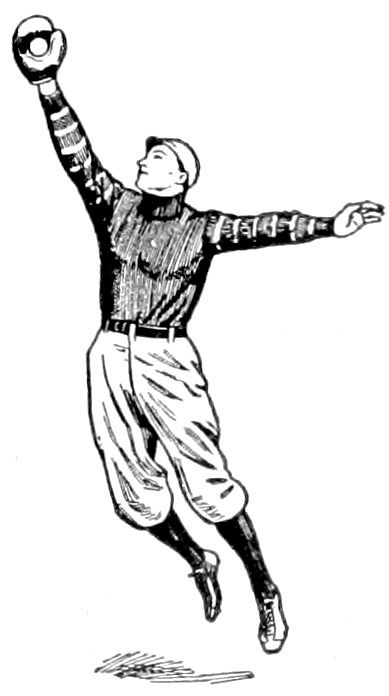
Jerseys are being used more and more by base ball players, especially for early Spring and late Fall games. The Spalding line includes a complete assortment of styles and qualities.
We allow two inches for stretch in all our Jerseys, and sizes are marked accordingly. It is suggested, however, that for very heavy men a size about two inches larger than coat measurement be ordered to insure a comfortable fit.
STOCK COLORS PLAIN COLORS—The following stock colors are supplied in our worsted jerseys (NOT Nos. 6 or 6X) at regular prices. Other colors to order only in any quality (EXCEPT Nos. 6 and 6X), 25c. each extra.
| No. 1P. | Full regular made; that is, fashioned or knit to exact shape on the machine and then put together by hand, altogether different from cutting them out of a piece of material and sewing them up on a machine as are the majority of garments known as Jerseys. Special quality worsted. Solid stock colors. | Each, | $4.50 |
| No. 10P. | Worsted, fashioned. Solid stock colors, | Each, | $3.00 |
| No. 12P. | Worsted; solid stock colors. | Each, | $2.75 |
| No. 12XB. | Boys’ Jersey. Worsted. Furnished in sizes 26 to 36 inches chest measurement only. Solid stock colors only. No special orders. | Each, | $2.00 |
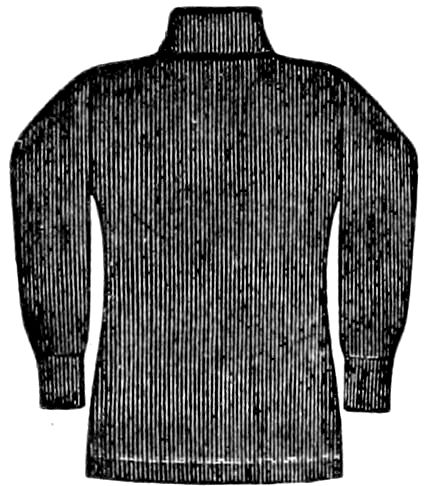
Nos 1P, 10P and 12P
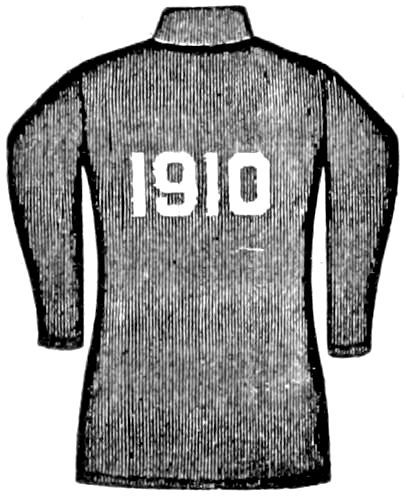
SPECIAL NOTICE We will furnish any of the above solid color Jerseys, (except Nos. 6 and 6X) with one color body and another color (not striped) collar and cuffs in stock colors only at no extra charge.
| No. 6. | Cotton, good quality, fashioned, roll collar, full length sleeves. Colors: Black, Navy Blue, Gray and Maroon only. | Each. | $1.00 |
| No. 6X. | Cotton, same as No. 6, but with striped sleeves in following combinations only: Navy with White or Red stripe; Black with Orange or Red stripe; Maroon with White stripe. | Each. | $1.25 |
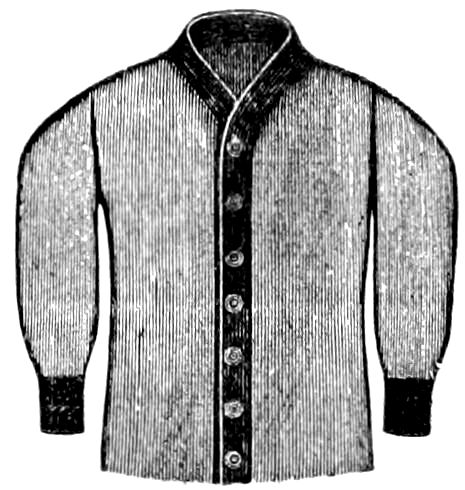
Nos. 10C and 12C
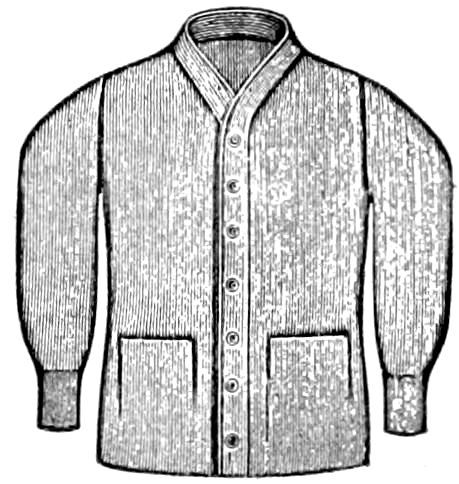
No. 10CP
The Spalding Coat Jerseys are made of the same worsted yarn from which we manufacture our better grade Jerseys, Nos. 10P and 12P, and no pains have been spared to turn them out in a well made and attractive manner. Plain solid stock colors (not striped) or one solid stock color body and sleeves with different stock color solid trimming (not striped) on cuffs, collar and front edging. Pearl buttons.
| No. 10C. | Same grade as our No. 10P. | Each, | $3.50 |
| No. 12C. | Same grade as our No. 12P. | Each, | $3.00 |
| No. 10CP. | Pockets, otherwise same as No. 10C. | Each, | $4.25 |
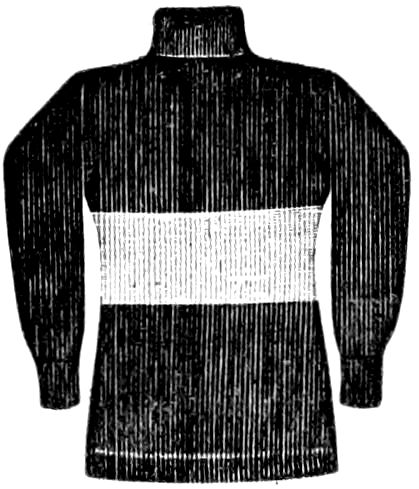
Nos. 10PW and 12PW
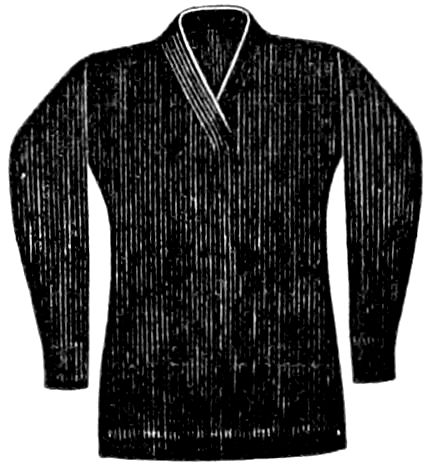
No. 12PV
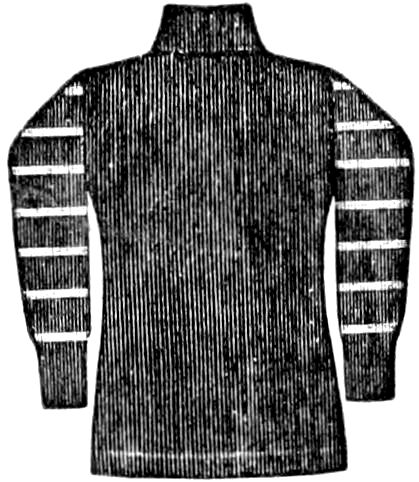
Nos. 10PX and 12PX
| No. 10PW. | Good quality worsted, same grade as No. 10P. Solid stock color body and sleeves, with 6–inch stock color stripe around body. | Each, | $3.50 |
| No. 12PW. | Worsted, solid stock color body and sleeves with 6–inch stock color stripe around body. | Each, | $3.00 |
| No. 10PX. | Good quality worsted, fashioned; solid stock color body, with stock color striped sleeves, usually alternating two inches of same color as body, with narrow stripes of any other stock color. | Each, | $3.50 |
| No. 12PV. | Worsted, solid stock colors, with V-neck instead of full collar as on regular jerseys. | Each, | $3.00 |
| No. 12PX. | Worsted, solid stock color body, with stock color striped sleeves, usually alternating two inches of same color as body, with narrow stripes of any other stock color. | Each, | $3.00 |
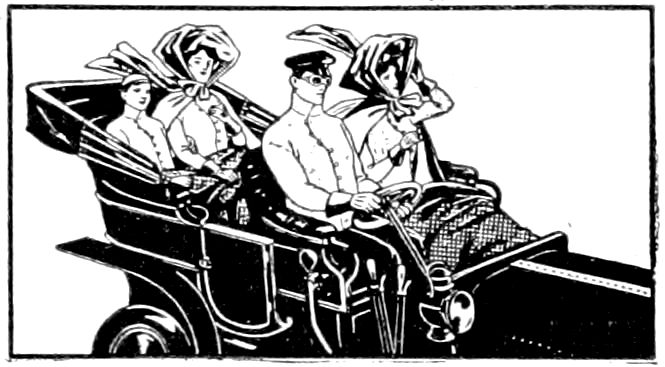
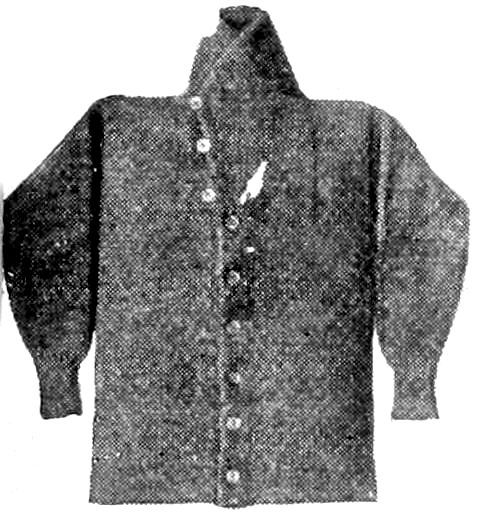
Collar Turned Up
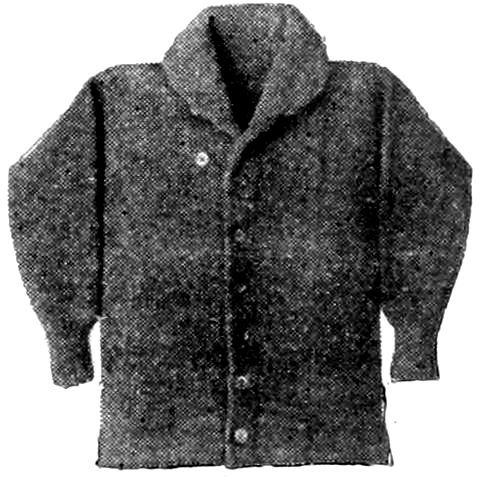
Collar Turned Down
No. WJ. Most satisfactory and comfortable style for automobilists; also useful for training purposes, reducing weight, tramping during cold weather, golfing, shooting, tobogganing, snowshoeing; in fact, for every purpose where a garment is required to give protection from cold or inclement weather. High collar that may be turned down, changing it into neatest form of button front sweater. Highest quality special heavy weight worsted. Sizes, 28 to 44 inches. In stock colors. Each, $8.50
PLAIN COLORS—All Spalding Sweaters are supplied in any of the colors designated, at regular prices. Other colors to order only in any quality, 50c. each garment extra.
SPECIAL NOTICE—We will furnish any of the solid color sweaters with one color body and another color (not striped) collar and culls in stock colors only at no extra charge. N. B.—We designate three shades which are sometimes called RED: These are Scarlet, Cardinal and Maroon. Where RED is specified on order Scarlet will be supplied.
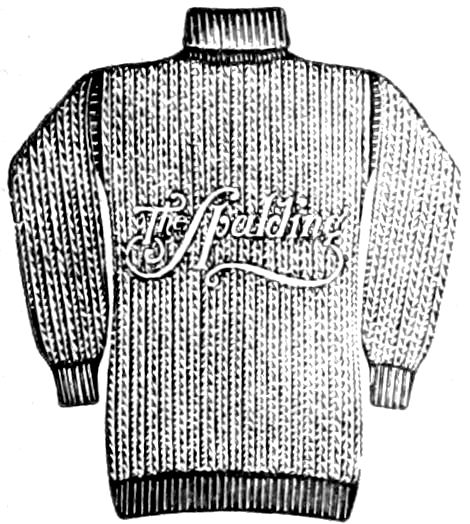
We allow four inches for stretch in all our sweaters, and sizes are marked accordingly. It is suggested, however, that for very heavy men a size about two inches larger than coat measurement be ordered to insure a comfortable fit.
WORSTED SWEATERS. Made of special quality wool, and exceedingly soft and pleasant to wear. They are full fashioned to body and arms and put together by hand, not simply stitched up on a machine as are the majority of garments sold as regular made goods.
| No. AA. | The proper style for use after heavy exercise, inducing copious perspiration, for reducing weight or getting into condition for athletic contests. Particularly suitable also for Foot Ball and Skating. Heaviest sweater made. In stock colors. | Each, | $9.00 |
| No. A. | “Intercollegiate.” In stock colors. Special weight. | „ | 7.00 |
| No. B. | Heavy weight. In stock colors. | „ | 6.00 |
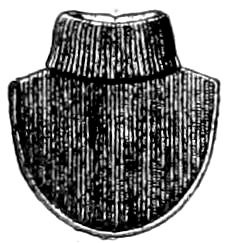
Front View
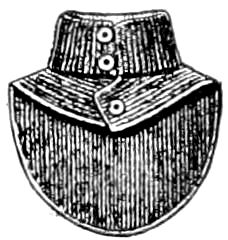
Back View
| No. M. | Special weight; highest quality worsted in solid stock colors to match our sweaters. | Each, | $1.25 |
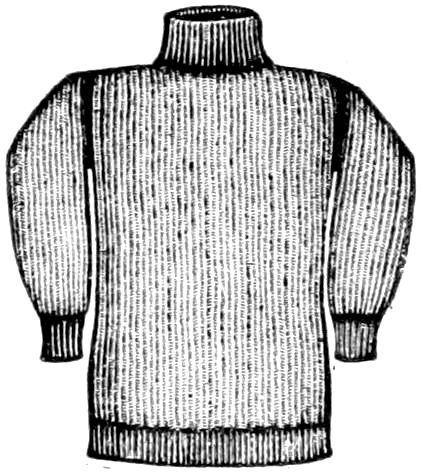
In Stock Colors
Sizes 30 to 44 in.
Fills a demand for as heavy a weight as our “Highest Quality” grade, but at a lower price.
| No. 3. | Standard weight, slightly lighter than No. B. | Each, | $4.00 |
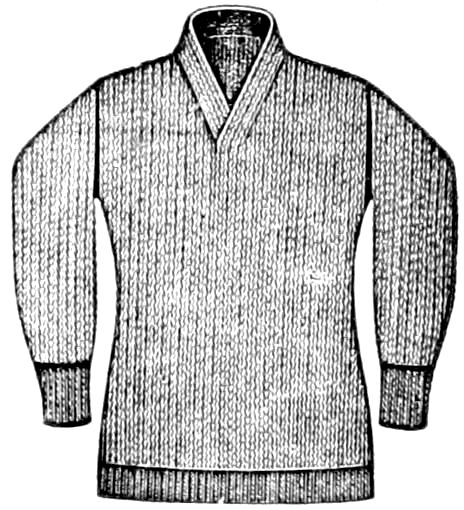
| No. BG. | Best quality worsted, good weight; with extreme open or low neck. In stock colors. | Each, | $6.00 |
PLAIN COLORS—All Spalding Sweaters are supplied in any of the following stock colors at regular prices. Other colors to order only in any quality 50c. each extra.
SPECIAL NOTICE—We will furnish any of the solid color sweaters mentioned below with one color body and another color (not striped) collar and cuffs in stock colors only at no extra charge. This does not apply to the No. 3JB Boys’ Sweater.
Sizes 28 to 44 inch chest measurement. We allow four inches for stretch in all our sweaters, and sizes are marked accordingly. It is suggested, however, that for very heavy men a size about two inches larger than coat measurement be ordered to insure a comfortable fit.
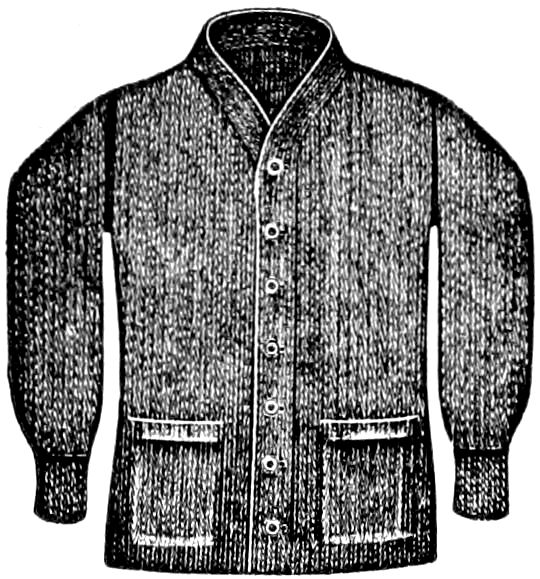
No. VGP
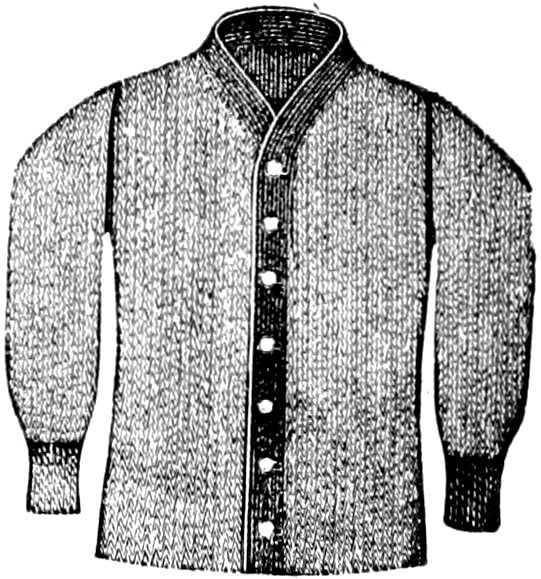
No. VG. Showing special trimmed edging and cuffs supplied, if desired, on jacket sweaters at no extra charge.
| No. VG. | Best quality worsted, heavy weight, pearl buttons. Made in regular stock colors, also in Dark Brown Mixture. | Each, | $7.00 |
| No. DJ. | Fine worsted, standard weight, pearl buttons, fine knit edging. Made in regular stock colors, also in Sage Gray. | Each, | $6.00 |
| No. 3J. | Standard weight wool, Shaker knit, pearl buttons. In stock colors. | Each, | $5.00 |
| No. VGP. | Best quality worsted, heavy weight, pearl buttons. In stock colors. With pocket on either side and a particularly convenient and popular style for golf players. | Each, | $7.50 |
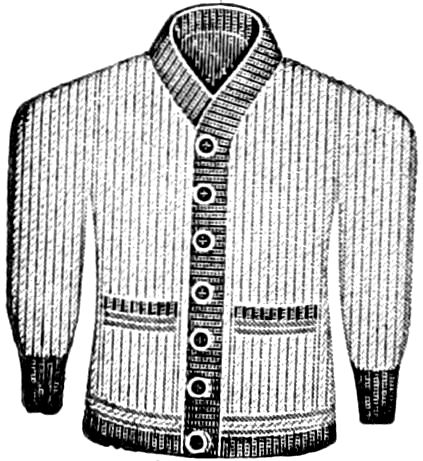
No. CDW
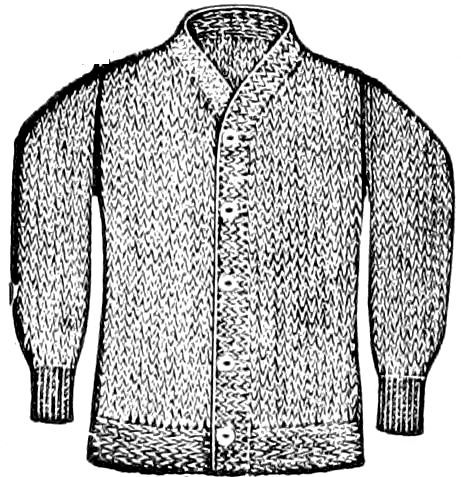
No. 3JB
| No. 3JB. | This is an all wool jacket sweater, with pearl buttons; furnished only in sizes from 30 to 36 inches chest measurement. In stock colors. | Each, | $3.50 |
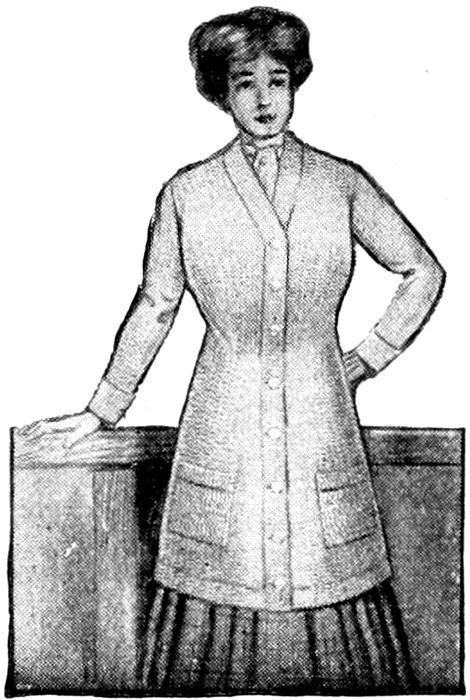
Knit in the Spalding athletic stitch of best quality long fibre worsted; full fashioned to shape of body on special machine and finished by hand. Cuffs, pocket and edging of special stitch. Good quality pearl buttons. Patch pockets. Attractive in appearance and, being properly made, they fit well and give satisfactory wear. Furnished in regular stock colors.
| No. LDJ. | Ladies’ Sweater, regular button front. | Each, | $8.00 |
| No. LWJ. | With special reversible collar, as on our Men’s No. WJ Automobile Sweater. | Each, | $10.00. |
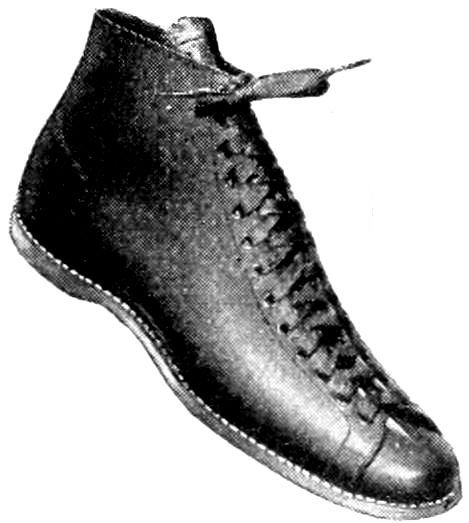
No. 15
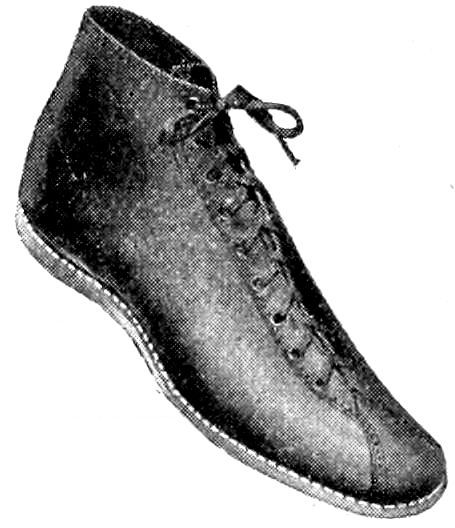
No. 155
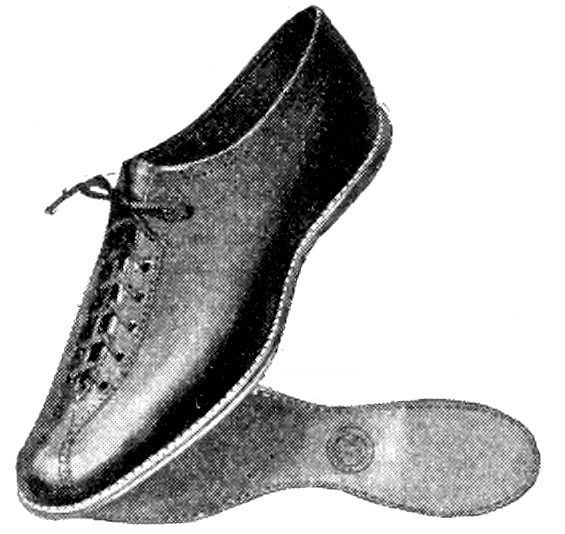
No. 166
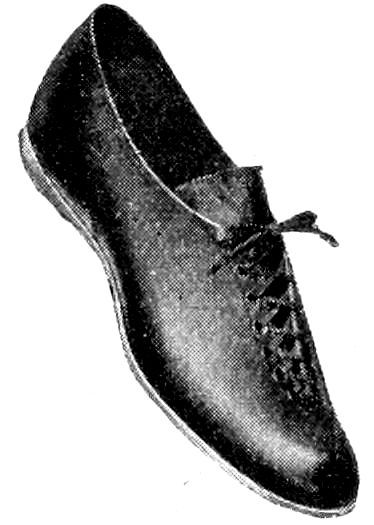
No. 90L
| No. 15. | High cut, Kangaroo, elkskin sole, extra light, hand made | Per pair, | $5.00 |
| No. 155. | High cut, Elkskin sole, soft and flexible; in ladies’ and men’s sizes. | „ | 4.50 |
| No. 166. | Low cut, selected leather, extra light and electric sole; ladies’ and men’s sizes. | „ | 3.00 |
| No. 90L. | Ladies’. Low cut, black leather, electric sole and corrugated rubber heel. | „ | 2.00 |
| No. 85L. | Ladies’. Low cut, black leather, roughened electric sole. | „ | 2.00 |
| No. 19. | Low cut, horse hide leather, flexible oak sole, roughened. | „ | 2.00 |
| No. 19L. | Ladies’. Otherwise as No. 19. | „ | 2.00 |
| No. 21. | High cut, black leather, electric sole. | „ | 2.00 |
| No. 20. | Low cut. Otherwise as No. 21. | „ | 1.75 |
| No. 20L. | Ladies’. Otherwise as No. 20. | „ | 1.75 |
| Spalding Ladies’ Gymnasium Shoes—Flexible Soles | |||
|---|---|---|---|
| No. BHL. | Good quality selected leather, black color, with elkskin sole, high cut. | Per pair, | $1.50 |
| No. PL. | Elkskin, pearl color, elkskin soles, high cut. | „ | 1.50 |
| No. OPL. | Same as No. PL, except low cut. | Pair, | 1.25 |
| No. OHL. | Same as No. BHL, but low cut. | „ | 1.25 |
| No. SL. | Selected drab color leather, high cut. | „ | 1.00 |
| No. OSL. | Same as No. SL, except low cut. | „ | .90 |
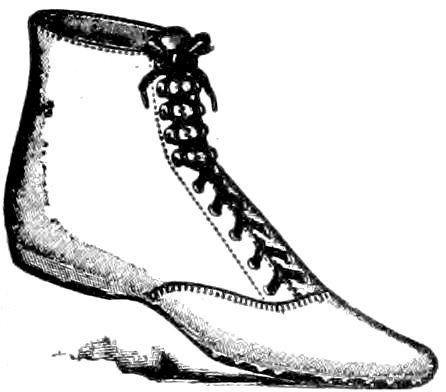
No. IH
| MEN’S | |||
|---|---|---|---|
| Sizes 6 to 12 inclusive. | |||
| No. IH. | High cut, best quality white rubber soles. Men’s of white canvas, ladies’ of black. | Per pair, | $1.75 |
| No. I. | Low cut. Otherwise as No. IH. | „ | 1.50 |
| No. M. | High cut. | „ | 1.00 |
| No. K. | Low cut. | „ | .85 |
| BOYS’ | |||
| Sizes 2½ to 5½ inclusive. | |||
| No. IHB. | High cut, best quality white rubber soles. Boys’ of white canvas, girls’ of black. | Per pair, | $1.50 |
| No. IB. | Low cut. Otherwise as No. IHB. | Per pair, | $1.25 |
| No. MS. | High cut. | .90 | |
| No. KB. | Low cut. | .75 | |
| YOUTHS’ | |||
| Sizes 11 to 2 inclusive. | |||
| No. IHX. | High cut, best quality white rubber soles. Youths’ of white canvas, misses’ of black. | Per pair, | $1.25 |
| No. IX. | Low cut. Otherwise as No. IHX. | $1.10 | |
| No. MX. | High cut. | .75 | |
| No. KX. | Low cut. | .65 | |
| No. E. | Low cut canvas shoe, canvas sole. Very popular for gymnasium. | Per pair, | .35 |
| No. 86. | Low cut, good quality, black leather, roughened electric sole. Sizes 12 to 5 inclusive, only. | Per pair, | $1.50 |
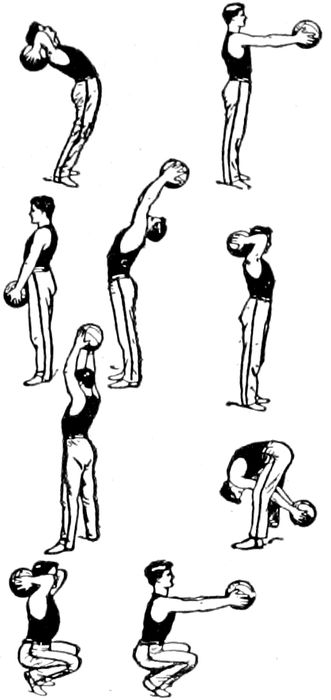
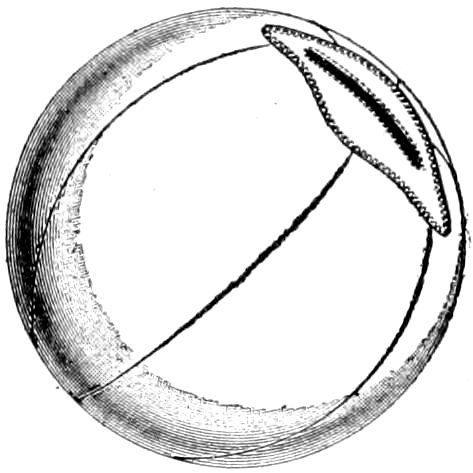
Weigh from four to eleven pounds. The covering is of selected tan leather, sewn in the same manner as our foot balls. Quality throughout has been much improved and the balls as now made are extremely durable. The exercise consists of throwing ball to one another, and the catching of it develops the chest, exercises the back, arms, legs; in fact, improves the whole system.
| No. 11. | 4–pound Ball. | Each, | $5.00 |
| No. 12. | 6–pound Ball. | „ | 6.00 |
| No. 13. | 9–pound Ball. | „ | 7.00 |
| No. 14. | 11–pound Ball. | „ | 10.00 |
“One of the aims of physical training is to make exercise interesting and enjoyable. To be beneficial in the highest sense it must be recreative. Particularly is this true of physical exercise for business men. As a class, in their daily work, they are kept on a constant mental strain. Besides, they are, to a large degree, physically inactive. Life becomes too intense, too serious, too sordid. Exercise therefore, for business men, must be largely recreative, relaxing and restful.”—Extract from Spalding Athletic Library, No. 262—“Exercises with the Medicine Ball.”
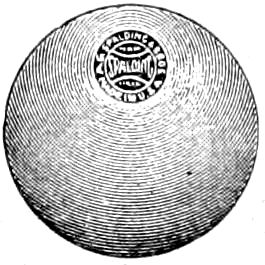
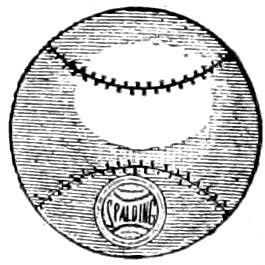
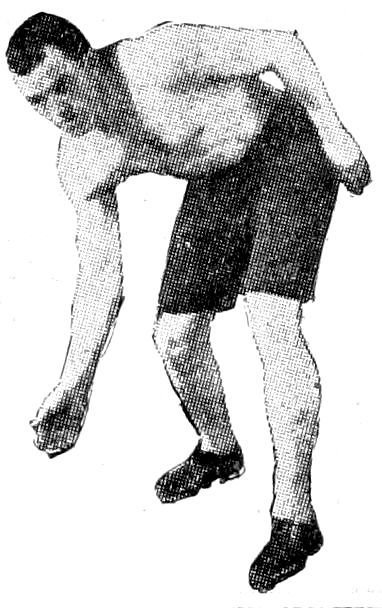
| No. 1. | Match, regulation size and weight, leather cover. | Each, | $1.25 |
| No. 2. | Expert, leather cover. | „ | .85 |
| No. 6. | Rubber, best quality, almost solid. | „ | .40 |
| No. 4. | Amateur, leather cover. | „ | .25 |
| No. 5. | Rubber hand ball. | „ | .25 |
| Red Ace, Irish Regulation red rubber ball. | Each, | 50c. | |
| Black Ace, Irish Regulation black rubber ball. | „ | 50c. |
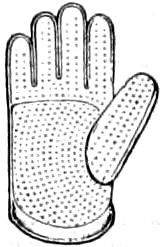
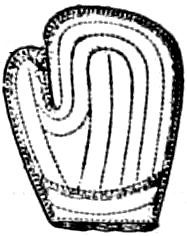
| No. A. | Gloves. Best quality glove leather with stitched front and special wrist pad. | Pair, | $4.00 |
| No. B. | Mitts. Lightly padded. | 3.00 | |
| No. C. | Gloves. Full fingered. | 4.50 | |
| No. D. | Fingerless Gloves. | .75 |
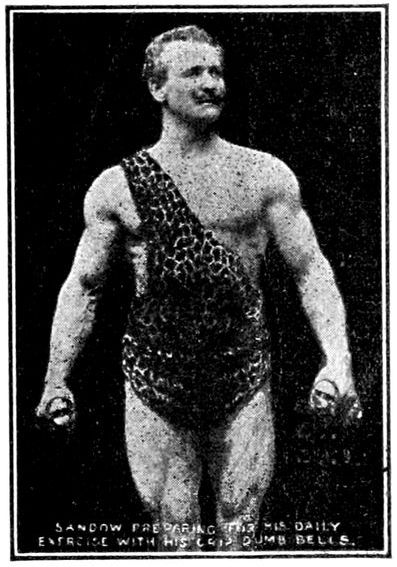
EUGEN SANDOW, Patentee.
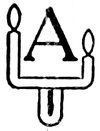
An entire system of Physical Culture is embraced within the exercises possible with these wonderful dumb bells.
The bells are made in two halves connected by steel springs, the effort necessary in gripping compelling the pupil to continually devote his whole mind to each movement. This concentration of will power on each muscle involved is what is responsible for the great results obtained through properly exercising with them.
| No. 6. | MEN’S. Nickel-plated; fitted with seven steel springs. | Per pair, | $3.00 |
| No. 4. | LADIES’. Nickel-plated; fitted with five steel springs. | Per pair, | $2.50 |
| No. 2. | BOYS’. Nickel-plated; fitted with four steel springs. | Per pair, | $2.00 |
We include with each pair of Sandow Dumb Bells a chart of exercises by Sandow and full instructions for using. Also a piece of selvyt cloth for keeping dumb bells in good condition.
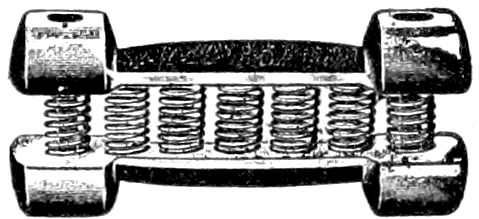
No. 6. MEN’S
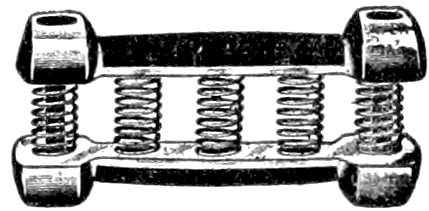
No. 4. LADIES’
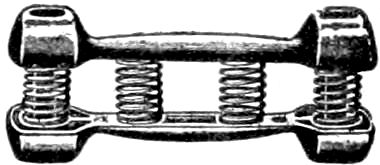
No. 2. BOYS’

“It is not so important to have big muscles as it is to have good digestion; it is not so important to have powerful muscles as it is to have a strong, regular heart; it is not so important to have great skill with one’s muscles as to have good lungs and kidneys.”—Extract from Spalding Athletic Library No. 161—“Ten Minutes Exercise for Busy Men.”
The value of a few minutes’ exercise daily with scientific and properly designed apparatus, is rapidly becoming apparent to the vast number of business men who find it simply impossible to take regular outdoor exercise.

Model E

Model B
Spalding Gold Medal Indian Clubs are made of selected first grade clear maple, in two popular models and are perfect in balance. Each club bears fac-simile of the Spalding Gold Medal. Each pair is wrapped in paper bag.
| ½ lb. Model E. | Pair, | $ .60 | |
| ¾ lb. Model E. | „ | .60 | |
| 1 lb. Model E. | „ | .70 | |
| 1½ lb. Model E. | „ | .80 | |
| 2 lb. Model E. | „ | 1.00 | |
| 3 lb. Model E. | „ | 1.20 |
| ½ lb. Model B. | Pair, | $.50 | |
| ¾ lb. Model B. | „ | .50 | |
| 1 lb. Model B. | „ | .55 | |
| 1½ lb. Model B. | „ | .60 | |
| 2 lb. Model B. | „ | .70 | |
| 3 lb. Model B. | „ | 1.00 |

Model ES

Model BS
The following clubs bear our Trade-Mark, are made of good material, and are far superior in shape and finish to the best clubs of other makes. Furnished in two popular models. Each pair wrapped in paper bag.
| ½ lb. Model ES. | Pair, | $.35 | |
| ¾ lb. Model ES. | „ | .35 | |
| 1 lb. Model ES. | „ | .40 | |
| 1½ lb. Model ES. | „ | .50 | |
| 2 lb. Model ES. | „ | .60 | |
| 3 lb. Model ES. | „ | .70 |
| ½ lb. Model BS. | Pair, | $.30 | |
| ¾ lb. Model BS. | „ | .30 | |
| 1 lb. Model BS. | „ | .35 | |
| 1½ lb. Model BS. | „ | .45 | |
| 2 lb. Model BS. | „ | .55 | |
| 3 lb. Model BS. | „ | .65 |

No. A

No. AA
Handsomely finished in ebonite and made for exhibition and stage purposes. The clubs are hollow, with a large body, and although extremely light, represent a club weighing three pounds or more.
| No. A. | Ebonite finish. | $3.50 | |
| No. AA. | With German Silver Bands. | Pair, | $5.00 |
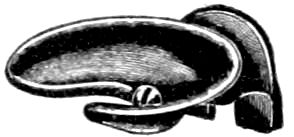
No. 1
Made of iron and nicely japanned.
| No. 1. | For Indian Clubs or Dumb Bells. | Per pair, | 16c. |
| No. 1M. | For Indian Clubs or Dumb Bells, mounted on oak strips. | Per pair, | 25c. |


Model A
Spalding Gold Medal Dumb Bells are made of selected first grade clear maple, and are perfect in balance. Each bell bears fac-simile of the Spalding Gold Medal. Each pair is wrapped in paper bag. Weights specified are for each bell.
| ½ lb. | ¾ lb. | 1 lb. | 1½ lb. | 2 lb. | |
| Pair, | 40c. | 45c. | 50c. | 55c. | 65c. |

Model AW
Spalding Trade-Mark quality. Made of good material and superior in shape and finish to the best wood dumb bells of other makes. Each pair wrapped in paper bag. Weights specified are for each bell.
| ½ lb. | ¾ lb. | 1 lb. | 1½ lb. | 2 lb. | |
| Pair, | 30c. | 30c. | 35c. | 45c. | 55c. |
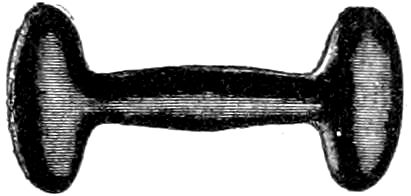
Made on approved models, nicely balanced and finished in black enamel.
| Sizes 2 to 40 pounds, | 6c. | ||
| Over 40 pounds, | 8c. | ||
| Bar Bells, any weight, wrought iron handles, any length made specially. | Pound, | 10c. |
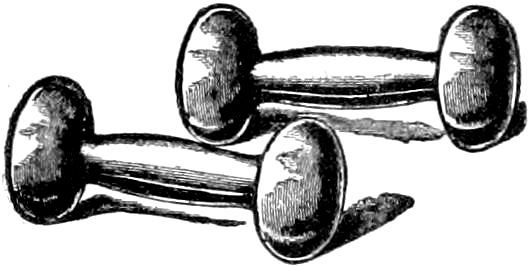
Nickel-plated and polished.
| 1N. | 1 lb. | $.25 | |
| 2N. | 2 lb. | .50 | |
| 3N. | 3 lb. | .65 | |
| 4N. | 4 lb. | .75 | |
| 5N. | 5 lb. | 1.00 |
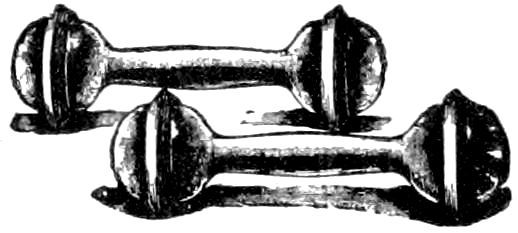
With Rubber Bands
Nickel-plated and polished.
| 1B. | 1 lb. | $.65 | |
| 2B. | 2 lb. | .75 | |
| 3B. | 3 lb. | 1.00 | |
| 4B. | 4 lb. | 1.15 | |
| 5B. | 5 lb. | 1.25 |

Model S. Has large pear shaped ends with a flexible hickory shaft ½ inch in diameter, producing a vibratory exercise, similar to that obtained with the French wand. Per dozen, $6.00

| No. 2. | Selected material, highly polished, 5 feet long. | Per dozen, | $5.00 |

| No. 3. | 3½ feet long. Made of straight grain maple. | Per dozen, | $1.30 |

| No. 4. | 4½ feet long. 1 inch diameter. | Per dozen, | $1.60 |
“If a Man gets plenty of food, and his digestive apparatus works it up into good rich blood; if the heart is strong and regular so that this good blood goes to all parts of the body with vigor and regularity, and if the respiratory and excretory apparatus is in such good order that this blood is kept pure, the fundamental conditions of health are laid.”—“Extracts from Spalding Athletic Library No. 161.”—“Ten Minutes’ Exercise for Busy Men.”
Rational exercise with simple but correct apparatus will enable almost any man to arrive at approximately a correct state of health.

Exercise acts on the health of an individual in the same way as the draught does on the fire in a furnace. Pile on the coal and shut off the draught and you kill the fire. Continue to eat heavy meals and take no exercise and your health will be affected, not because of the food you have eaten so much as on account of the lack of exercise. A little exercise is all that is necessary to keep you in good condition. Some rational, pleasant and interesting exercise, persisted in with regularity and, preferably, with Spalding Home Apparatus, will help you to retain your health.
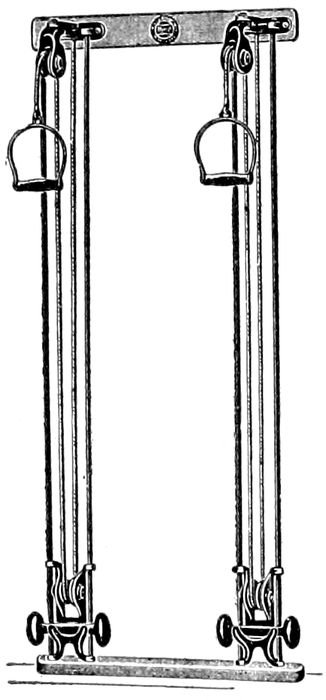
Spalding Chest Weight No. 2
An ideal machine for home use. Well made and easy running. Rods are ⅜-inch coppered spring steel. Bearings are hardened steel cone points running in soft, gray iron, noiseless and durable. Weight carriage packed with felt, good for long wear, but easily removed and replaced when necessary without the use of glue or wedges of any kind. Weight carriage strikes on rubber bumpers. Weights are 5–pound iron dumb-bells, one to each carriage, and may be removed and used as dumb bells. Wall and floor boards are hard wood, nicely finished and stained. All castings heavily japanned. Every part of machine guaranteed free of defect.
| No. 2. | Each, | $5.00 |

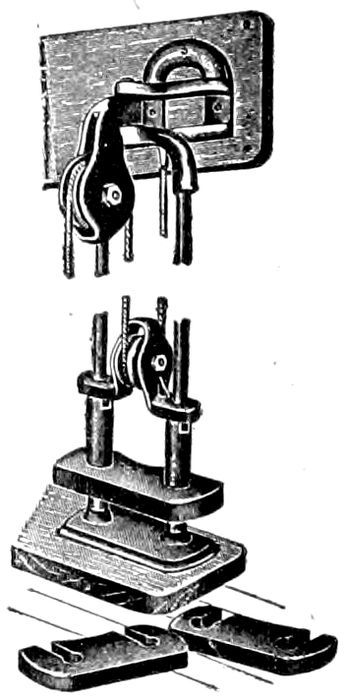
Showing important details of Construction of No. 12 Machine.
We have just added this very well made machine to our line. Cast iron parts are all nicely japanned. The wheels are iron, turned true on centers, and have hardened steel cone point bearings. The guide rods are spring steel, copper-plated. The weight carriage has removable felt bushings, noiseless and durable. Each handle is equipped with 10 lbs. of weights.
| No. 12. | Each, | $10.00 |
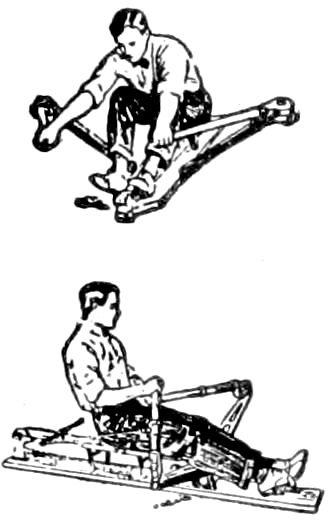
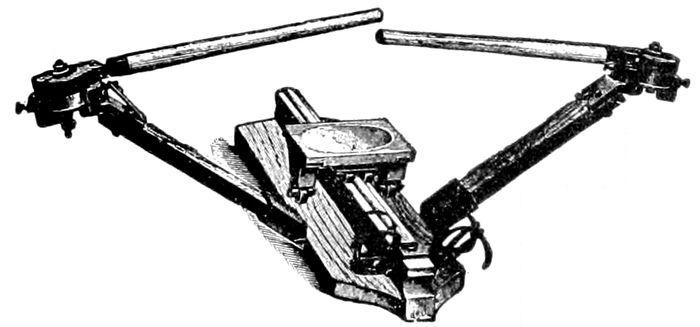
Do not use oil on friction cylinder. If its action is not perfectly smooth a little clear soap rubbed on its surface will properly correct its action. The means used to produce the resistance is a simple friction clutch, which takes instant hold at the commencement of the stroke and retains the pressure till its completion, when it instantly releases it precisely as in a boat. Quickly taken apart without loosening any bolts or screws. Each machine is adjustable to any amount of friction or resistance.
| No. 119. | Complete, | $16.00 |
The apparatus listed in this catalogue is designed particularly for private use; i. e., in homes and private gymnasiums. It retains the same superior marks of quality which distinguish the regular line of gymnasium apparatus manufactured by A. G. Spalding & Bros., but its distinctive design permits it to be sold at a price more in keeping with its use than heretofore obtainable, without any sacrifice of practical value or durability.
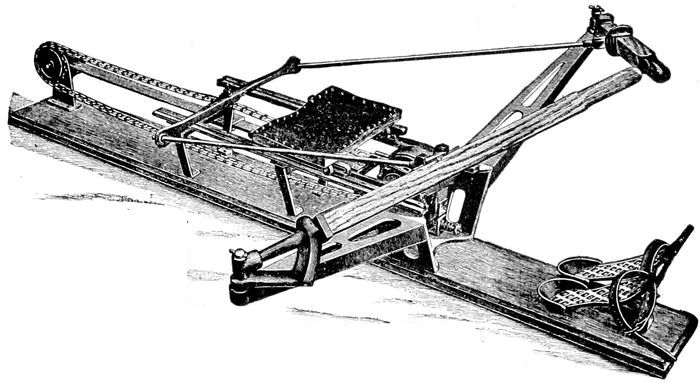
Operated just like rowing a boat
The ideal boat for home use and training purposes. Used by the leading athletic clubs, colleges and prominent oarsmen of the world, and pronounced the most perfect rowing machine ever produced. Fitted with the Kerns’ Patent Roller Seat and Shoes, the shoes having a three-inch adjustment, to suit either a tall or a short person. By turning a thumb-nut the belt can be tightened to any desired degree, and more or less friction thrown into the running parts, imitating the resistance which exists when forcing a row-boat through the water. The weaker sex can use the machine by simply loosening the thumb-nut which reduces the resistance; and on the other hand, by reversing the operation the resistance can be so increased that the strongest athlete can have any amount of resistance. The oars are pivoted in such a way that the operator can handle and turn them the same as he would during the return and feathering motion with a boat oar.
| No. 600. | Kerns’ Patent Single Scull Rowing Machine | Each, | $30.00 |
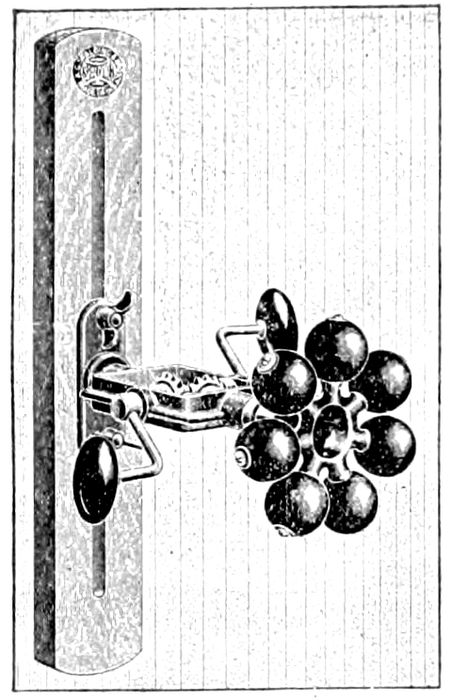
Useful for treatment of constipation, based upon the principle of muscular contraction (the force which nature uses). By its mechanical arrangement, it effectually applies force in the same direction that nature does, and will gradually discard the use of cathartics. Only a few moments’ use at the proper time is necessary before its effects will be felt. Its action upon the liver and stomach is equally as prompt and effective, and derangements of these organs are speedily remedied.
Gentlemen: I have used the Spalding Automatic Abdominal Masseur in my practice for over fifteen years. I have found it of great benefit in chronic constipation and indigestion. Your improvement increases its value.
| The Spalding Abdominal Automatic Masseur. | Complete, | $10.00 |
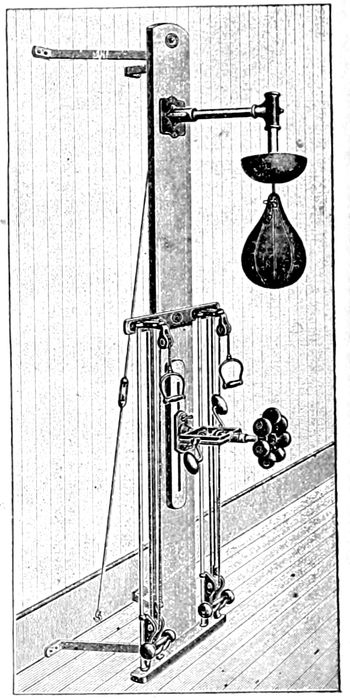
Convenient, does not take up much room, is always ready, and is really the most compact, simplest and best arrangement for providing a complete set of home exercising apparatus that has ever been devised.—CONSISTS OF
| Board with attachments for fastening to floor of room so that walls need not be marred. | $10.00 | ||
| Spalding Abdominal Masseur. | 10.00 | ||
| No. PR | Spalding Adjustable Striking Bag Disk. | 5.00 | |
| No. 2 | Spalding Chest Weight Machine, including pair of 5–lb. Dumb Bells. | 5.00 | |
| No. 14 | Spalding Striking Bag. | 1.50 | |
| Complete, all attached, | $31.50. | ||
| Board itself will be furnished separately if desired. | Each, | $10.00 |
Board only is fastened to floor. Braces padded with leather, so that walls will not be damaged. Can be put up in any room with a ceiling 8 ft. high. As the complete outfit is made up and carried in stock by us, equipped as noted above, we cannot supply board with different articles already attached.
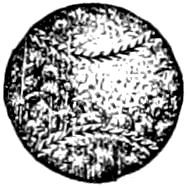
| No. A. | Consists of an iron ball, which is wound with electric tape and is then covered with a very soft and smooth grade of horsehide. It is made in either 6 or 8 lbs. weight. | Each, | $5.00 |
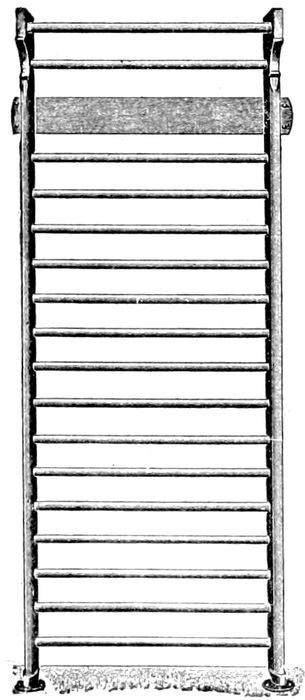
This apparatus is particularly adapted for use in the home, as it is compact, of simple construction, and may be used for the greatest variety of movements affecting every part of the body, and especially abdomen and chest movements. May be erected against wall, behind a door, or against any other flat surface. Dimensions are eight feet high, thirty-six inches wide and extends six inches into the room.
| No. 20H. | For home use. | Per section. | $8.00 |
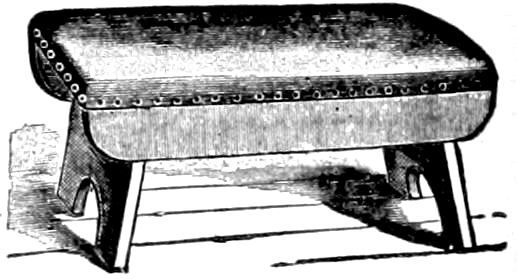
Hard pine, strong and substantial. Top is padded with hair felt, canvas covered. It is preferable, for sanitary reasons, that this canvas be painted (a special elastic paint is used), unless otherwise specified, stock benches will be so furnished.
| No. 205. | Single. | Ea, | $4.00 |
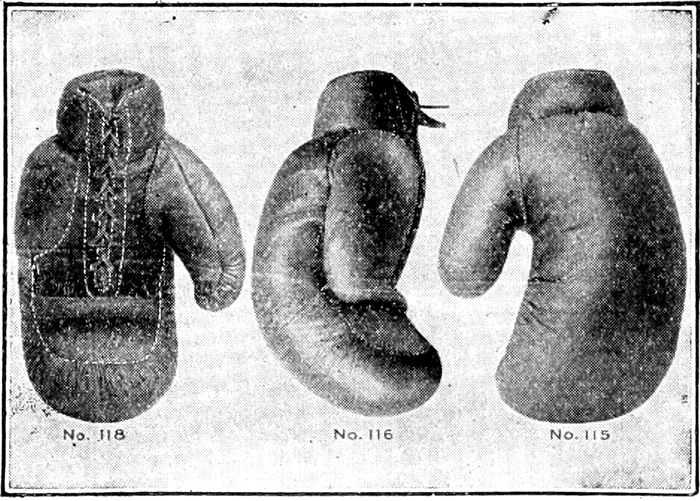
The Spalding “Championship” Gloves are endorsed by all champions and have been exclusively used for years in championship contests and in training. The material and workmanship are of the highest quality, the fit is perfect, and by their peculiar construction absolutely prevent any chance of injury to the hands or wrists. Each set is carefully inspected before packing and guaranteed in every particular. Made in three sizes in sets of four gloves.
| No. 115. | The Spalding 5–oz. “Championship” Glove. | Per set of four gloves, | $6.00 |
| No. 116. | The Spalding 6–oz. “Championship” Glove. | Per set of four gloves, | $6.00 |
| No. 118. | The Spalding 8–oz. “Championship” Glove. | Per set of four gloves, | $6.50 |
Same style as our “Championship” 8–oz. Gloves, but not same quality material and workmanship.
| No. 218. | Per set of four gloves, | $4.50 |
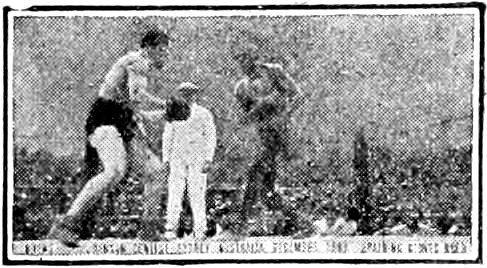
BURNS vs. JOHNSON SPALDING GLOVES USED
Kerry Copyright.
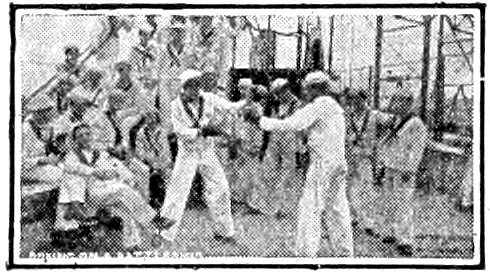
BOXING IN THE NAVY
COPYRIGHT, 1905, BY G. W. FAWCETT
These gloves are made of a special “sea green” leather, of particularly durable quality. Furnished in 8–oz. only, similar in style to No. 118, and with padded wrist.
| No. 18N. | Per set of four gloves, | $5.00 |
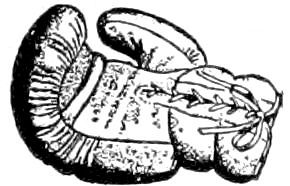
Spalding Pupil’s Boxing Glove
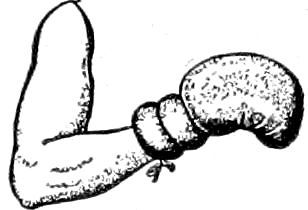
Padding on Wrist and Forearm
Acting on the suggestion of one of the most prominent athletic officials in this country, we decided recently to get up a boxing glove that would be an aid to the pupil learning to box. This glove is additionally padded on the forearm and over the wrist, to prevent that soreness which is one of the most discouraging features following a brisk lesson in the art of “blocking.” The glove part is well padded with curled hair, the leather being best quality soft tanned.
| No. 110. | Per set of four gloves, | $6.00 |
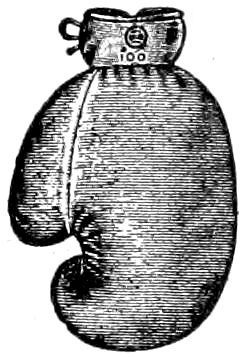
Made of best grade brown glove leather, extra heavily padded over the knuckles and with special large padded thumb to prevent injury to either instructor or pupil. Laces extra far to provide ample ventilation and has patent palm grip.
| No. 100. | Per set of four gloves, | $6.00 |
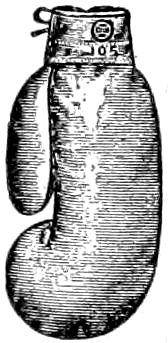
Made of special quality light tan-colored glove leather, very soft and smooth. Plain laced wristband, patent palm lacing and patent palm grip. An ideal glove for limited round contests.
| No. 105. | Per set of four gloves, | $7.00 |
| No. 11. | Corbett pattern, large 7–oz. glove, best quality brown glove leather, padded with best curled hair, patent palm lacing, padded wristband, patent palm grip. Substantially made throughout for hard usage. | Set of four gloves, | $5.00 |
| No. 9. | Regulation 5–oz. glove, otherwise same as No. 11. | Set of four gloves, | $5.00 |
| No. 14. | Regulation 5–oz. glove, dark wine color, padded wristband, patent palm lacing and palm grip. Much improved. | Set of four gloves, | $4.00 |
| No. 15. | Corbett pattern, olive tanned leather, well padded with hair, padded wristband, patent palm lacing, patent palm grip. | Set of four gloves, | $4.00 |
| No. 17. | Corbett pattern, craven tan leather, well padded with hair, patent palm lacing, patent palm grip, padded wristband. | Set of four gloves, | $4.00 |
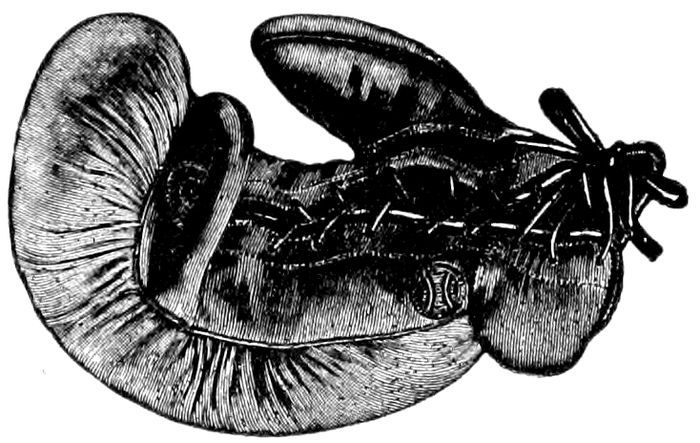
Above illustrates the patent palm lacing and patent palm grip referred to in descriptions of Spalding boxing gloves. With these improvements we believe our line is absolutely the finest on the market. The patent palm lacing, insuring a snug fit at all times, is a very valuable feature, and the patent palm grip we know, will be appreciated by those who want gloves that are up-to-date in every particular.
| No. 19. | Corbett pattern, craven tan leather, well padded with hair, patent palm grip and patent palm lacing. | Set of four gloves, | $3.50 |
| No. 21. | Corbett pattern, dark wine color leather. Well padded with hair and patent palm lacing. | Set of four gloves, | $3.00 |
| No. 23. | Regular pattern, fine quality brown tanned leather. A very well made glove. Hair padded and patent palm lacing. | Set of four gloves, | $2.00 |
| No. 24. | Regular pattern, craven tan leather, hair padded, elastic wristband. | Set. | $1.50 |
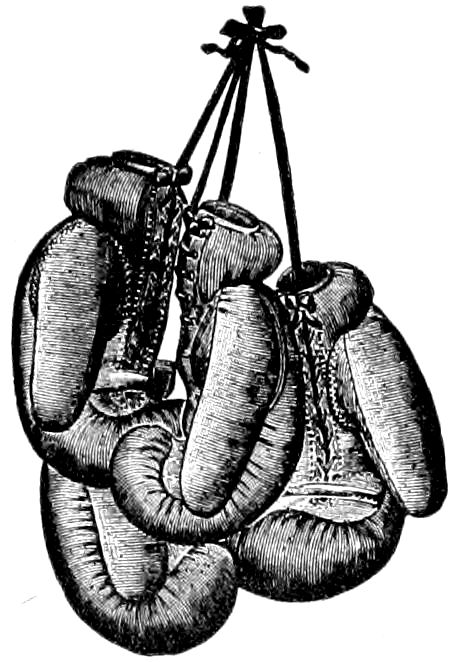
No. 11. Corbett Pattern
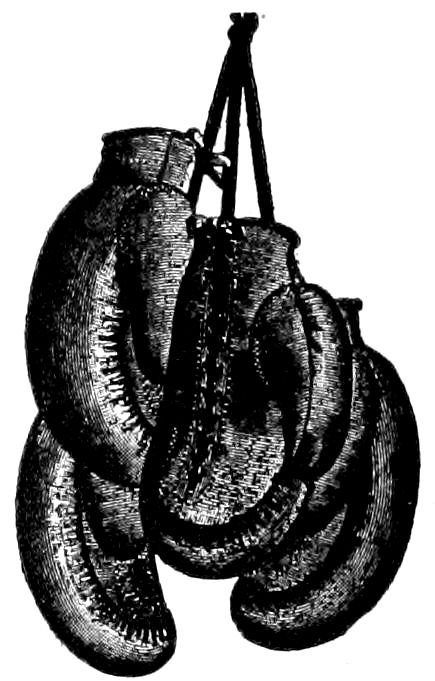
No. 23. Regular Pattern
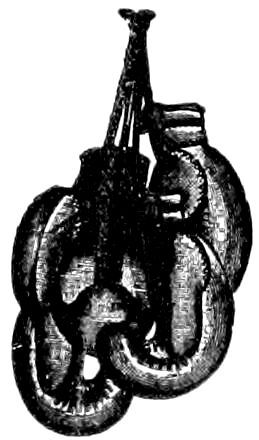
No. 45 Corbett Pattern
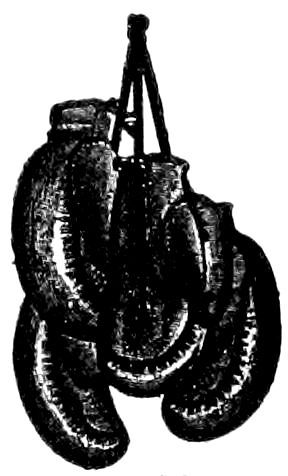
No. 25 Regular Pattern
Spalding Youths’ Boxing Gloves are made in exactly the same manner and of the same material as the full size gloves of our manufacture and are warranted to give satisfaction.
| No. 45. | Youths’ Championship Glove, Corbett pattern, best quality brown glove leather, extra well finished and double stitched, patent palm lacing and patent palm grip. | Set of four gloves, | $3.50 |
| No. 40. | Youths’ size, Corbett pattern, soft craven tan leather, well padded, patent palm lacing. | Set of four gloves, | $2.50 |
| No. 25. | Youths’ size, regular pattern, soft tanned leather, patent palm lacing. | Set of four gloves, | $1.50 |
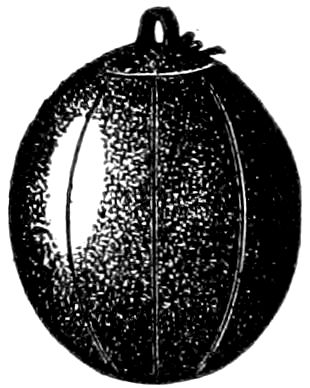
No. G
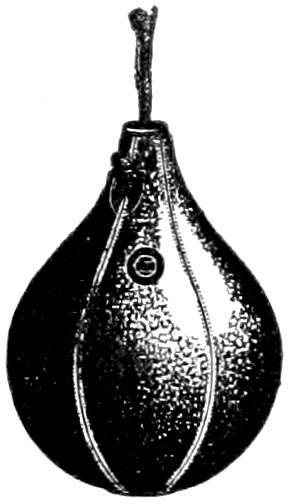
No. 19
All our single end bags except No. G are made with solid leather top, through center of which rope passes, making them the most certain in action of any. Laces on side at top, so that the bladder can be inflated without interfering with rope. Each bag is most carefully inspected and then packed complete in box with bladder, lace and rope.
| No. G. | This is a heavy durable Gymnasium Bag suitable for all around exercise work and the strongest bag made. The cover is of heavy English grain leather, same as used in our best grade foot balls and basket balls and made in the same way. It will outlast two or three bags of any other make. With loop top. | Each, | $8.00 |
| No. 19. | Made of highest quality Patna kid, the lightest and strongest of leather. Sewed with linen thread, double stitched and red welted seams. Especially suited for exhibition work, and a very fast bag. | Each, | $7.00 |
| No. 19S. | Same material as No. 19, but furnished with special light bladder and weighs only 7 ounces complete. The fastest bag made, but very strong and durable. | Each, | $7.00 |
| No. 20. | Made of finest selected calfskin, double stitched, red welted seams and reinforced throughout. Very fast and a durable bag for all around use. | Each, | $7.00 |
| No. 18. | The “Fitzsimmons Special.” Made of finest selected olive Napa tanned leather, extra well made; double stitched, red welted seams and reinforced throughout. For training purposes particularly this bag will be found extremely satisfactory in every respect. | Each, | $5.00 |
| No. 18S. | Same as No. 18, but smaller in size and lighter. Intended for very speedy work. | Each, | $5.00 |
| No. 12. | Olive tanned leather, specially selected; double stitched, red welted seams and reinforced throughout. Excellent for quick work. | Each, | $4.00 |
| No. 10. | Specially tanned brown glove leather; double stitched, red welted seams and reinforced throughout. Very well made. | Each, | $3.50 |
| No. 17. | Made of fine craven tanned leather, well finished; double stitched, red welted seams and reinforced throughout. A good bag. | Each, | $3.50 |
| No. 16. | Extra fine grain leather, full size and lined throughout. | Each, | $3.00 |
| No. 15. | Made of olive tanned leather, full size and lined throughout; red welted seams. | Each, | $2.00 |
| No. 14. | Good quality colored sheepskin; lined throughout. | Each, | $1.50 |
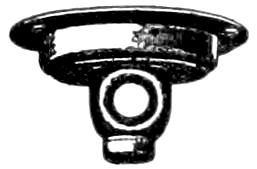
No. 8
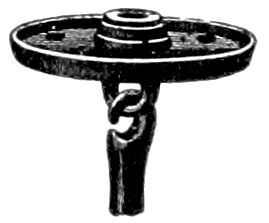
No. 11
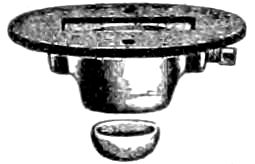
No. 9
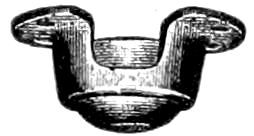
No. 12
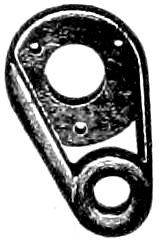
No. 8
| No. 8. | The simplest and most effective ball bearing swivel on the market. Rope can be changed instantly without interfering with any other part of swivel. | Each, | $1.50 |
| No. 9. | With removable socket for quickly suspending or removing bag without readjusting. | Each, | 50c. |
| No. 11. | Swivel action, with bell cord coupling and rope attached. Fastens permanently to disk; japan finish. | Each, | 50c. |
| No. 6. | Japanned iron stem for use with platform or disk. | Each, | 35c. |
| No. 12. | Ball and socket action. Fastens permanently to disk; nickel-plated. | Each, | 25c. |
We are making all our double end bags with one-piece top and substantial leather hop. Really the strongest construction we know of. The bottom loop is also very strongly made. Each bag complete in box, with bladder, lace, rubber cord for floor, and rope for ceiling attachment.

| No. 7. | Made of finest selected olive Napa tanned leather and workmanship of same quality as in our “Fitzsimmons” Special Bag No. 18. Double stitched, red welted seams. An extremely durable and lively bag. | Each, | $5.50 |
| No. 6. | Fine olive tanned leather cover, double stitched, red welted seams. Extra well made throughout. | Each, | $5.00 |
| No. 5. | Regulation size, specially tanned brown glove leather cover, red welted seams, double stitched and substantially made throughout. | Each, | $4.00 |
| No. 4½. | Regulation size, fine craven tanned leather and red welted seams. Well finished throughout. | Each, | $3.75 |
| No. 4. | Regulation size, fine grain leather cover and well made throughout, double stitched. | Each, | $3.50 |
| No. 3. | Regulation size, substantial brown leather cover, reinforced and double stitched seams. | Each, | $2.50 |
| No. 2½. | Regulation size, good quality dark olive tanned leather, lined throughout, red welted seams. | Each. | $2.00 |
| No. 2. | Medium size, good colored sheepskin, lined throughout. | Each, | $1.50 |
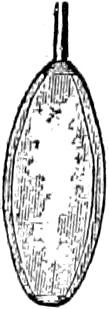
Style for Double End Bags and No. G
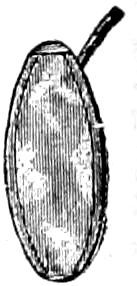
Style for Single End Bags
It is well to specify when ordering extra bladders whether they are required for single or double end bags, as we can furnish the two styles in each grade.
| No. B. | With top stem, for Nos. 2, 2½ and 3. | Each, | 75c. |
| No. BS. | With side stem, for Nos. 14 and 15. | Each, | 75c. |
| No. 5. | With top stem, for Nos. 4, 4½, 5 and 6. | Each, | $1.00 |
| No. 5S. | With side stem, for Nos. 10, 12, 16 and 17. | Each, | $1.00 |
| No. 7S. | With side stem, for Nos. 18, 18S, 19, 19S and 20. | Each, | $1.20 |
| No. 7. | With top stem, for No. 7. | 1.20 | |
| No. OM. | Top stem for No. G. | 1.50 | |
| No. OS. | With top stem, heavy bladder, best quality. | Each, | $1.25 |
| No. D. | Elastic floor attachment for all double end bags, best quality cord. | Each, | 30c. |
| No. E. | Elastic cord for double end bags. | Each, | 20c. |

| No. 2. | Club size, cylinder 10 in. | Each, | 50c. |
| No. 3. | Pocket size, cylinder 5½ in. | „ | 25c. |
All Rubber Bladders bearing our Trade-Mark are made of Pure Para Rubber (no composition) and are guaranteed Perfect in Material and Workmanship. Note special explanation of guarantee on tag attached to each bladder.
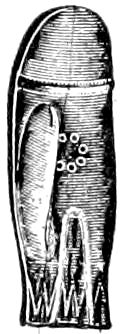
No. 1
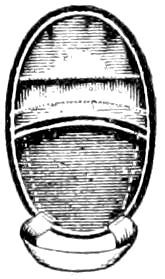
No. 4
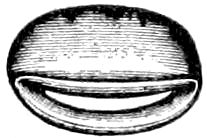
No. 5
| No. 1. | Made of olive Napa Leather and extra well padded; ventilated palm and special elastic wrist in glove. | Pair, | $2.50 |
| No. 2. | Made of soft tanned leather, properly shaped and padded; substantially put together. | Pair, | $1.50 |
| No. 3. | Made of soft tanned, leather, padded and well made; also made in ladies’ size. | Pair, | 75c. |
| No. 4. | Knuckle mitt, well padded. | „ | 50c. |
| No. 5. | Knuckle mitt, well padded, | „ | 25c. |
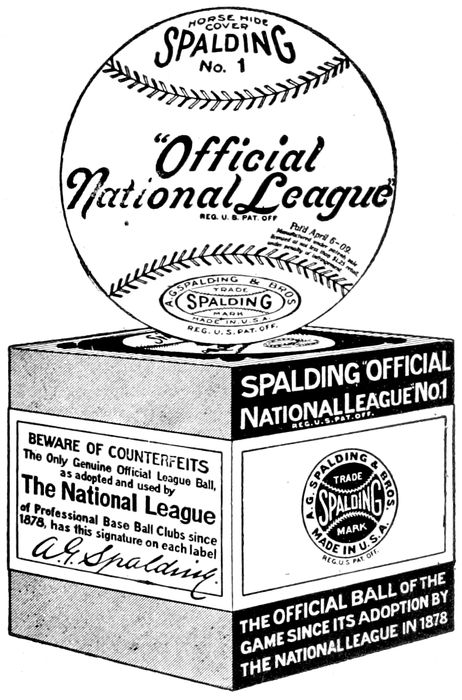
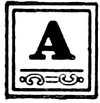
Adopted by the National League in 1878, and the only ball used in Championship games since that time. Each ball wrapped in tinfoil, packed in a separate box, and sealed in accordance with the latest League regulations. Warranted to last a full game when used under ordinary conditions.
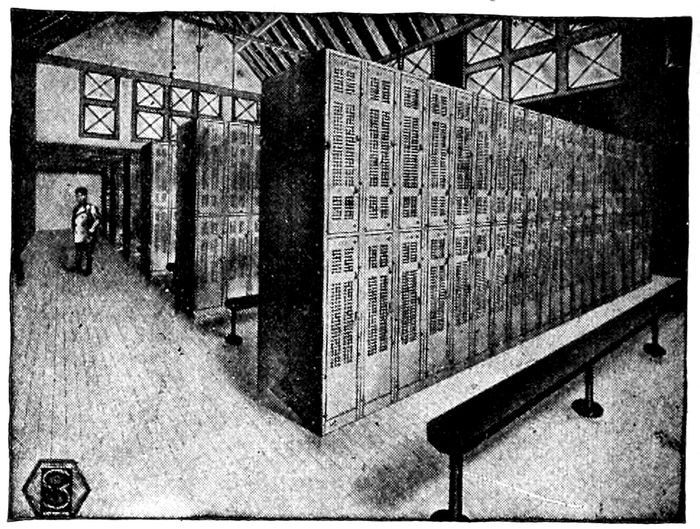
Some of the 6,000 Durand-Steel Lockers installed in the Public Gymnasiums of Chicago. 12″ × 15″ × 42″, Double Tier.
Wooden lockers are objectionable, because they attract vermin, absorb odors, can be easily broken into, and are dangerous on account of fire.
Lockers made from wire mesh or expanded metal afford little security, as they can be easily entered with wire cutters. Clothes placed in them become covered with dust, and the lockers themselves present a poor appearance, resembling animal cages.
Durand-Steel Lockers are made of finest grade furniture steel and are finished with gloss black, furnace-baked japan (400°), comparable to that used on hospital ware, which will never flake off nor require refinishing, as do paints and enamels.
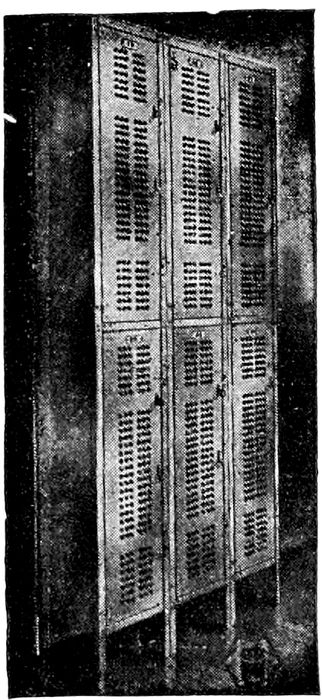
Six Lockers in Double Tier
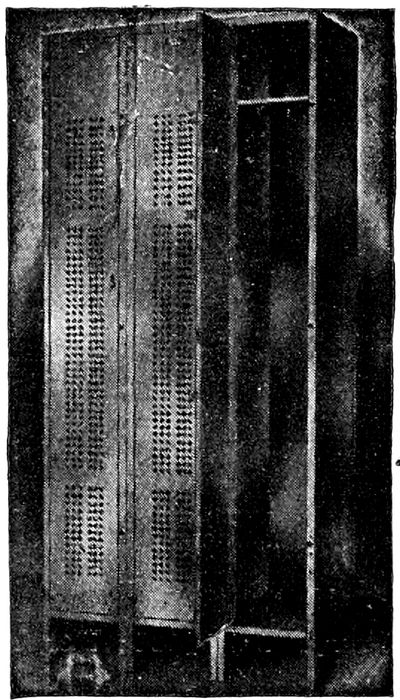
Three Lockers in Single Tier
Durand-Steel Lockers are usually built with doors perforated full length in panel design with sides and backs solid. This prevents clothes in one locker from coming in contact with wet garments in adjoining lockers, while plenty of ventilation is secured by having the door perforated its entire length, but, if the purchaser prefers, we perforate the backs also.
The cost of Durand-Steel Lockers is no more than that of first-class wooden lockers, and they last as long as the building, are sanitary, secure, and, in addition, are fire-proof.
We are handling lockers as a special contract business, and shipment will in every case be made direct from the factory in Chicago. If you will let us know the number of lockers, size and arrangement, we shall be glad to take up, through correspondence, the matter of prices.

The following selection of items from their latest Catalogue will give an idea of the great variety of ATHLETIC GOODS manufactured by A. G. SPALDING & BROS. SEND FOR A FREE COPY.
A Standard Quality must be inseparably linked to a Standard Policy.
Without a definite and Standard Mercantile Policy, it is impossible for a manufacturer to long maintain a Standard Quality.
To market his goods through the jobber, a manufacturer must provide a profit for the jobber as well as the retail dealer. To meet these conditions of Dual Profits, the manufacturer is obliged to set a proportionately high list price on his goods to the consumer.
To enable the glib salesman, when booking his orders, to figure out attractive profits to both the jobber and retailer, these high list prices are absolutely essential; but their real purpose will have been served when the manufacturer has secured his order from the jobber, and the jobber has secured his order from the retailer.
However, these deceptive high list prices are not fair to the consumer, who does not, and, in reality, is not ever expected to pay these fancy list prices.
When the season opens for the sale of such goods, with their misleading but alluring high list prices, the retailer begins to realize his responsibilities, and grapples with the situation as best he can, by offering “special discounts,” which vary with local trade conditions.
Under this system of merchandising, the profits to both the manufacturer and the jobber are assured; but as there is no stability maintained in the prices to the consumer, the keen competition amongst the local dealers invariably leads to a demoralized cutting of prices by which the profits of the retailer are practically eliminated.
This demoralization always reacts on the manufacturer. The jobber insists on lower, and still lower, prices. The manufacturer, in his turn, meets this demand for the lowering of prices by the only way open to him, viz.: the cheapening and degrading of the quality of his product.
The foregoing conditions became so intolerable that, ten years ago, in 1899, A. G. Spalding & Bros. determined to rectify this demoralization in the Athletic Goods Trade, and inaugurated what has since become known as “The Spalding Policy.”
The “Spalding Policy” eliminates the jobber entirely, so far as Spalding Goods are concerned, and the retail dealer secures his supply of Spalding Athletic Goods direct from the manufacturer under a restricted retail price arrangement by which the retail dealer is assured a fair, legitimate and certain profit on all Spalding Athletic Goods, and the consumer is assured a Standard Quality and is protected from imposition.
The “Spalding Policy” is decidedly for the interest and protection of the users of Athletic Goods, and acts in two ways:
First—The user is assured of genuine Official Standard Athletic Goods, and the same fixed prices to everybody.
Second—As manufacturers, we can proceed with confidence in purchasing at the proper time, the very best raw materials required in the manufacture of our various goods, well ahead of their respective seasons, and this enables us to provide the necessary quantity and absolutely maintain the Spalding Standard of Quality.
All retail dealers handling Spalding Athletic Goods are required to supply consumers at our regular printed catalogue prices—neither more nor less—the same prices that similar goods are sold for in our New York, Chicago and other stores.
All Spalding dealers, as well as users of Spalding Athletic Goods, are treated exactly alike, and no special rebates or discriminations are allowed to anyone.
Positively, nobody, not even officers, managers, salesmen or other employes of A. G. Spalding & Bros., or any of their relatives or personal friends, can buy Spalding Athletic Goods at a discount from the regular catalogue prices.
This, briefly, is the “Spalding Policy,” which has already been in successful operation for the past ten years, and will be indefinitely continued.
In other words, “The Spalding Policy” is a “square deal” for everybody.

An article that is universally given the appellation “Standard” is thereby conceded to be the Criterion, to which are compared all other things of a similar nature. For instance, the Gold Dollar of the United States is the Standard unit of currency, because it must legally contain a specific proportion of pure gold, and the fact of its being Genuine is guaranteed by the Government Stamp thereon. As a protection to the users of this currency against counterfeiting and other tricks, considerable money is expended in maintaining a Secret Service Bureau of Experts. Under the law, citizen manufacturers must depend to a great extent upon Trade-Marks and similar devices to protect themselves against counterfeit products—without the aid of “Government Detectives” or “Public Opinion” to assist them.
Consequently the “Consumer’s Protection” against misrepresentation and “inferior quality” rests entirely upon the integrity and responsibility of the “Manufacturer.”
A. G. Spalding & Bros. have, by their rigorous attention to “Quality,” for thirty-three years, caused their Trade-Mark to become known throughout the world as a Guarantee of Quality as dependable in their field as the U. S. Currency is in its field.
The necessity of upholding the guarantee of the Spalding Trade-Mark and maintaining the Standard Quality of their Athletic Goods, is, therefore, as obvious as is the necessity of the Government in maintaining a Standard Currency.
Thus each consumer is not only insuring himself but also protecting other consumers when he assists a Reliable Manufacturer in upholding his Trade-Mark and all that it stands for. Therefore, we urge all users of our Athletic Goods to assist us in maintaining the Spalding Standard of Excellence, by insisting that our Trade-Mark be plainly stamped on all athletic goods which they buy, because without this precaution our best efforts towards maintaining Standard Quality and preventing fraudulent substitution will be ineffectual.
Manufacturers of Standard Articles invariably suffer the reputation of being high-priced, and this sentiment is fostered and emphasized by makers of “inferior goods,” with whom low prices are the main consideration.
A manufacturer of recognized Standard Goods, with a reputation to uphold and a guarantee to protect, must necessarily have higher prices than a manufacturer of cheap goods, whose idea of and basis for a claim for Standard Quality depends principally upon the eloquence of the salesman.
We know from experience that there is no quicksand more unstable than poverty in quality—and we avoid this quicksand by Standard Quality.

